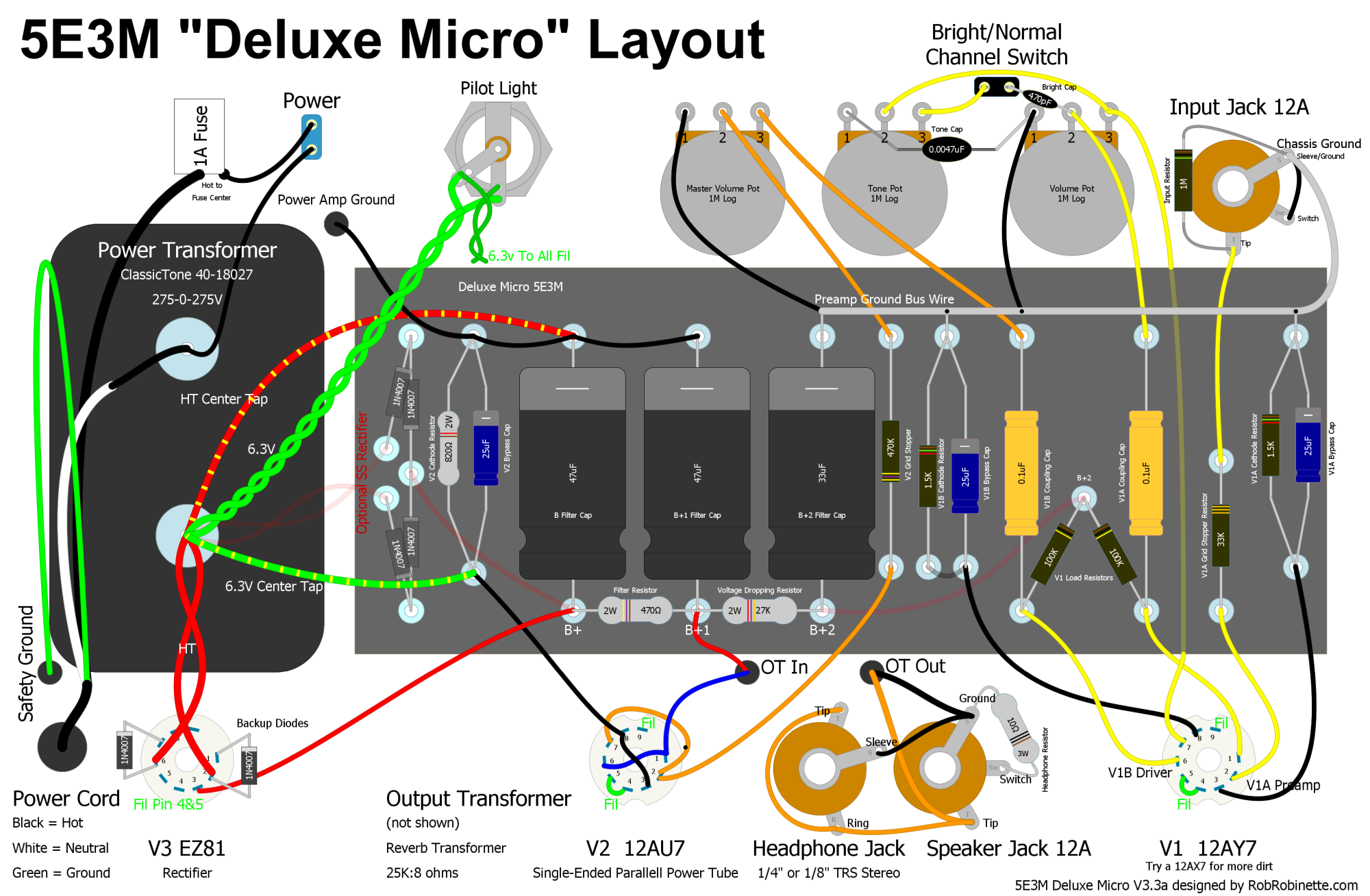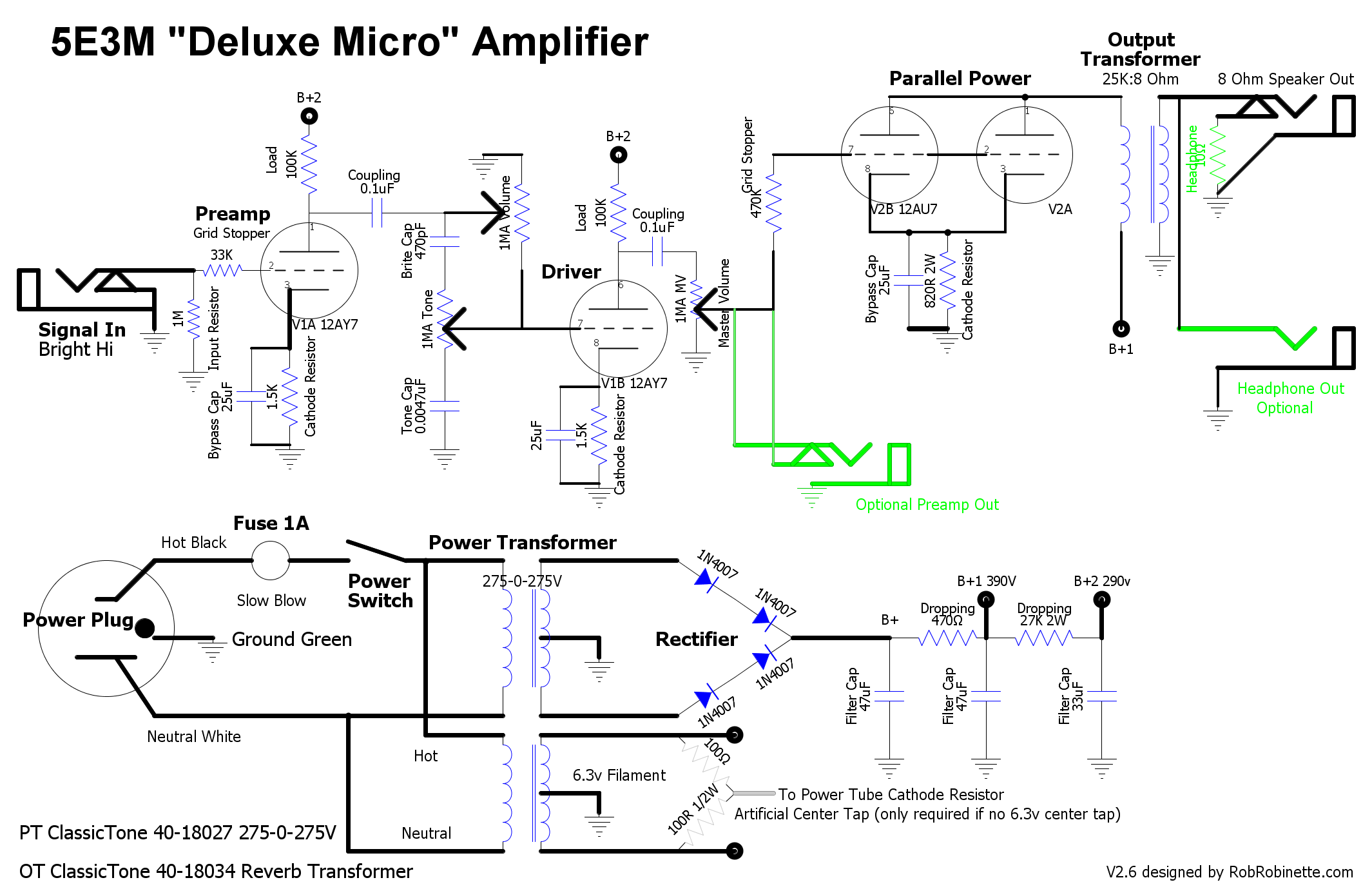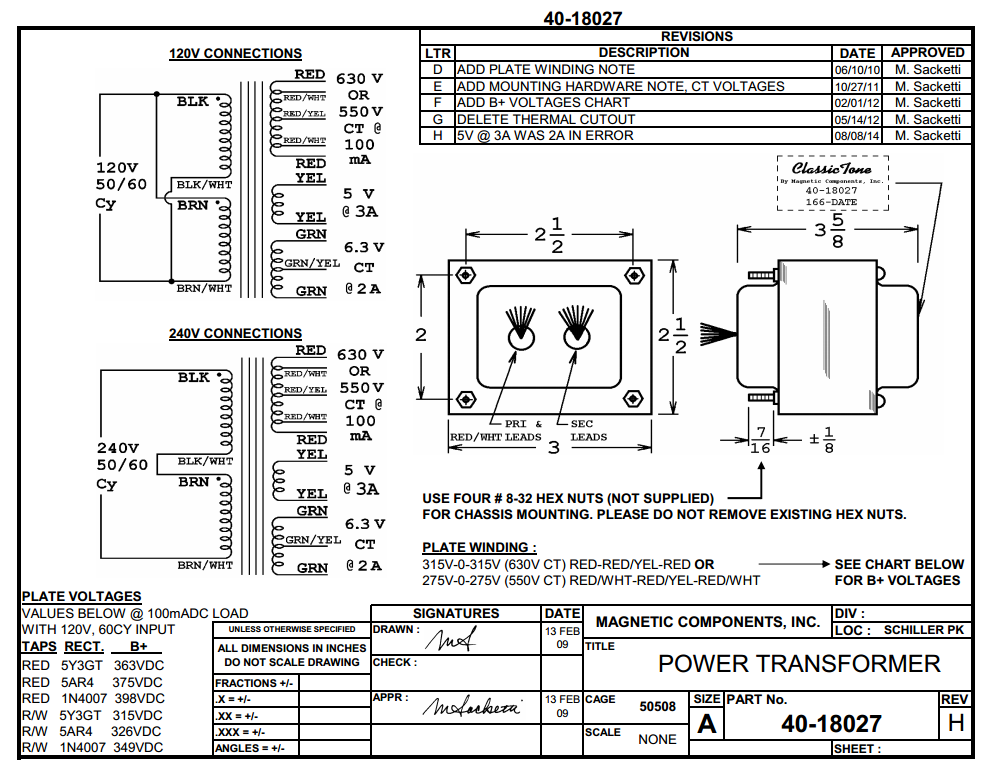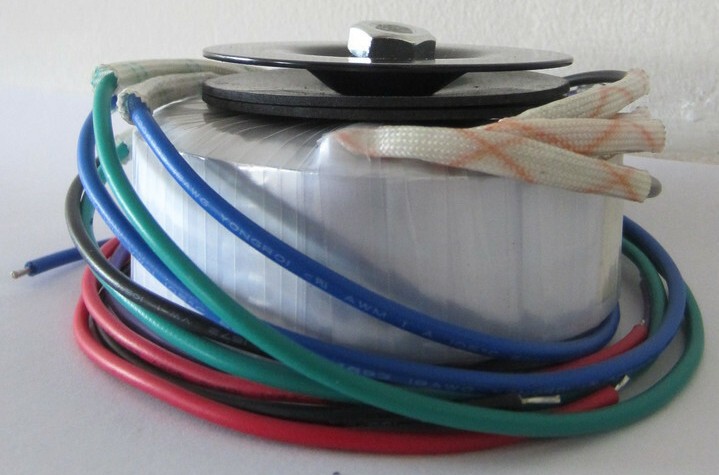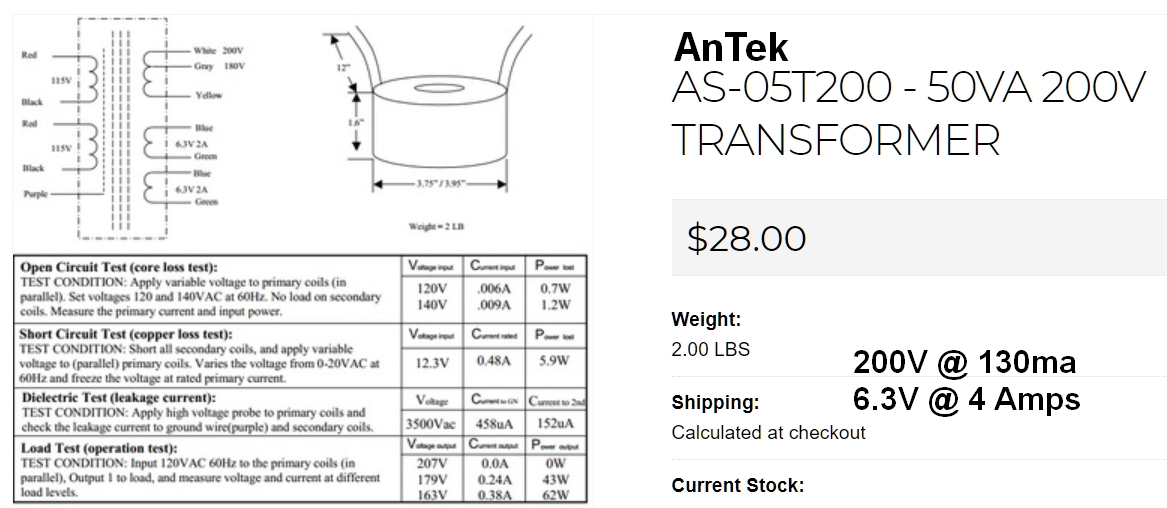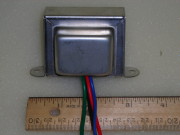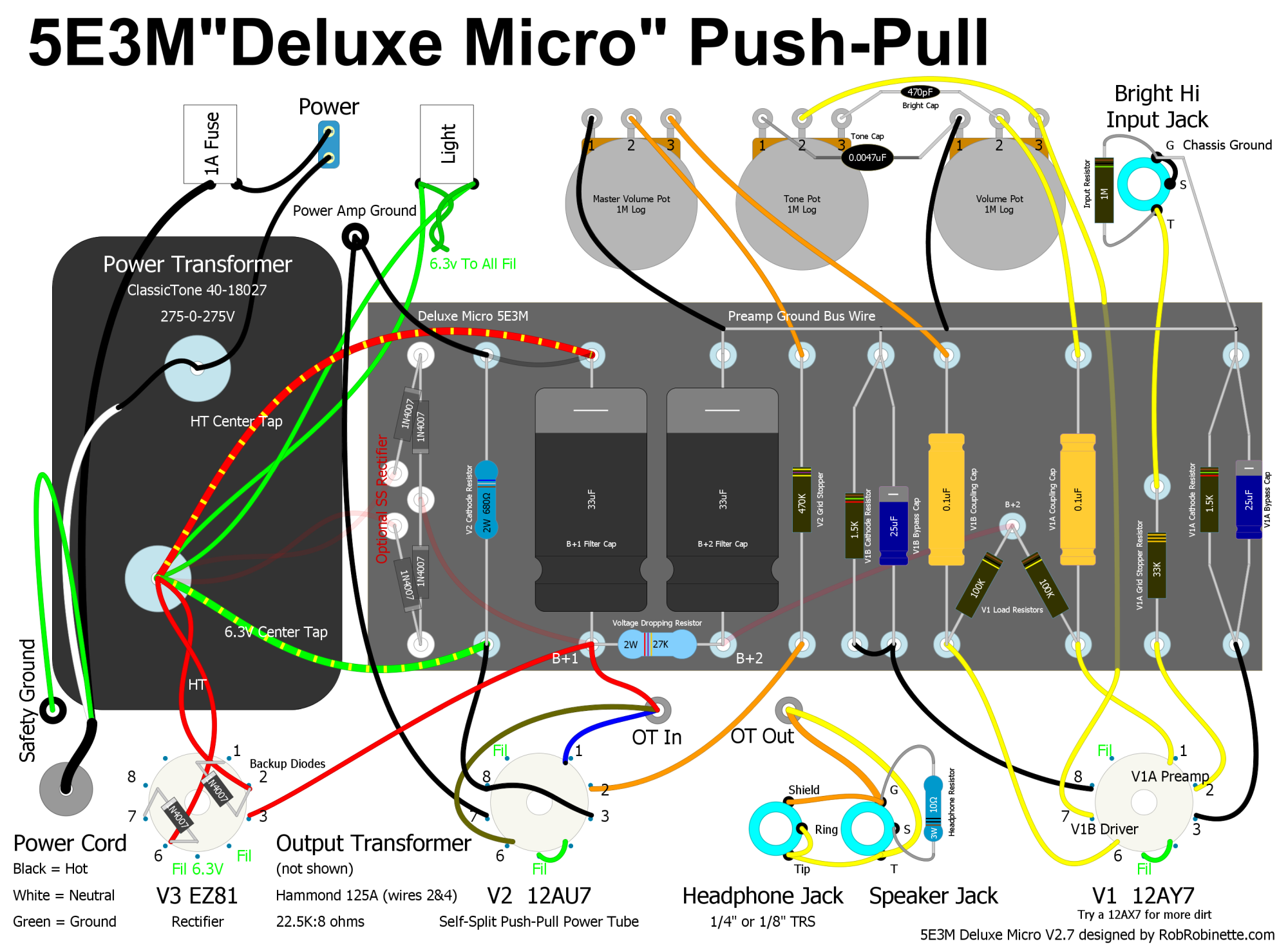5E3M Deluxe Micro© Guitar Amplifier
Have comments or corrections? Email rob at: robinette at comcast dot net
Updates
January 2021: I added an EF80 small pentode version of the Deluxe Micro. It has two channels and uses the 5E3 cathodyne phase inverter.
December 2020: Here is an excellent demo of a Deluxe Micro.
June 2020: Added Alan Gilsmith's Stereo Deluxe Micro audio amp.
March 2020: I bumped the power tube cathode resistor up to 820 ohms to cool the bias and added a Deluxe Micro Hoffman Board file you can upload to the Hoffman DIYLC File Analyzer page and have a board made.
May 2016: Here's a good quality sound clip that showcases different styles on Deluxe Micro #4.
Sep 2015: Deluxe Micro #3 builder Ty says, "Well, after the honeymoon is over and getting more familiar with the deluxe micro the more I love that thing. It is brilliant for home playing. The master volume is an absolute, like you said on an amp like that. I'm for sure going to build the Bassman Micro as soon as I have some strange cash. Keep up the good work! I finally got some recording done with the amp. So, on the dirt side I'm using a bjfe sea blue EQ and black arts tone works pharaoh. On the clean and dirty I am using a belton brick reverb and Mxr 10 band EQ. There are some glitches and knocks in it, oops. Didn't have time to refine it. Anyways, let me know what you think!!!!" Here's Ty's demo in mp3 and FLAC.
May 2015: Last change I swear. The ClassicTone 40-18028 300-0-300V power transformer gave me a power tube plate voltage of 417v which is hotter than I wanted. I added a pair of parallel 442 ohm 1/2 watt resistors (equivalent to a 221 ohm 1 watt resistor) between the rectifier tube and first filter cap to bring the plate voltage down to 400v. I intentionally left space for an extra dropping resistor on the circuit board for this very reason.
27 April 2015: Here's a short youtube clip of Deluxe Micro #3 by its builder.
23 April 2015: Added a self-split push-pull power tube option.
The Deluxe Micro design is an attempt to capture the magic of the late 1950's classic Fender tweed 5E3 Deluxe tube guitar amplifier in an easy to build, two tube, 1 watt output practice amp. The Deluxe Micro's single channel preamp circuit was inspired by the 5E3 Deluxe's Bright Hi channel. Both triodes of the V1 12AY7 are used as gain stages.
The power amp is simply a single-ended Class A design using a 12AU7 tube with both triodes strapped together (paralleled) feeding an $18 ClassicTone 25K to 8 Ohm reverb transformer rated at 3.5 watts as the output transformer. If you prefer to stick with a more 5E3 like push-pull amp I added an option for a very simple self-split push-pull power amp using the 12AU7. I also offer up a more complex Deluxe Micro Mod with added tone shaping switches to add versatility. One thing to consider is if you build the Deluxe Micro and don't like it, the power transformer and tubes can be used in a full size 5E3 Deluxe and other tube amp kits.
WARNING
The Deluxe Micro project utilizes POTENTIALLY FATAL HIGH VOLTAGES. If you are unfamiliar with high voltage circuits or are uncomfortable working around high voltages, DO NOT RISK YOUR LIFE BY BUILDING THEM. Seek help from a competent technician before building any unfamiliar electronics circuit. RobRobinette.com DISCLAIMS ALL LIABILITY FOR INJURY OR PROPERTY DAMAGE RESULTING FROM THIS INFORMATION. ALL INFORMATION IS PROVIDED 'AS-IS' AND WITHOUT WARRANTY OF ANY KIND. See more tube amplifier safety info here.
Eyelet or Turret Board Layout
One 12AY7 and one 12AU7 are all that's needed in the Deluxe Micro. Note the optional four diode rectifier on far left of circuit board and V3 EZ81 rectifier tube at bottom left--choose one rectifier. Click the image for the hi-res image. Here's the hi-res pdf layout. Download the DIY Layout Creator file here.
Shown with simple four diode rectifier. Layouts below show optional EZ81 tube rectifier if you prefer an all tube amplifier. Click on the image to see a hi-res pdf of the schematic (this is true of all the layout diagrams on this webpage). You can download the DIY Layout Creator file of the schematic here.
Deluxe Micro Bill of Materials
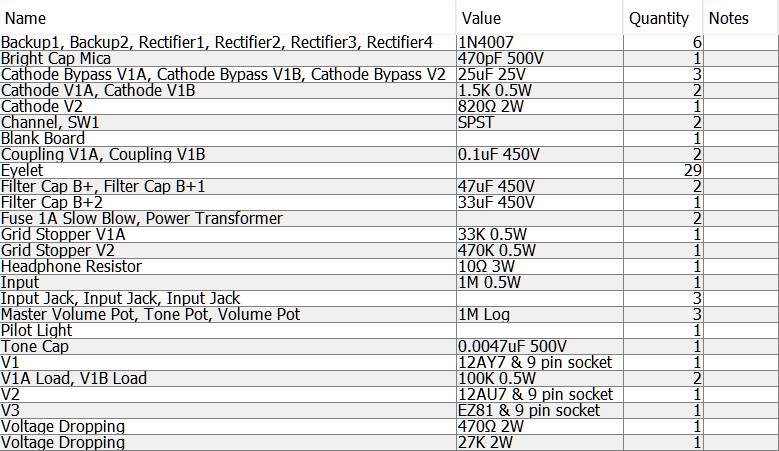
You'll also need a chassis, power & output transformers, cab, speaker and power cord.
Deluxe Micro #1 Prototype in Hammond Chassis
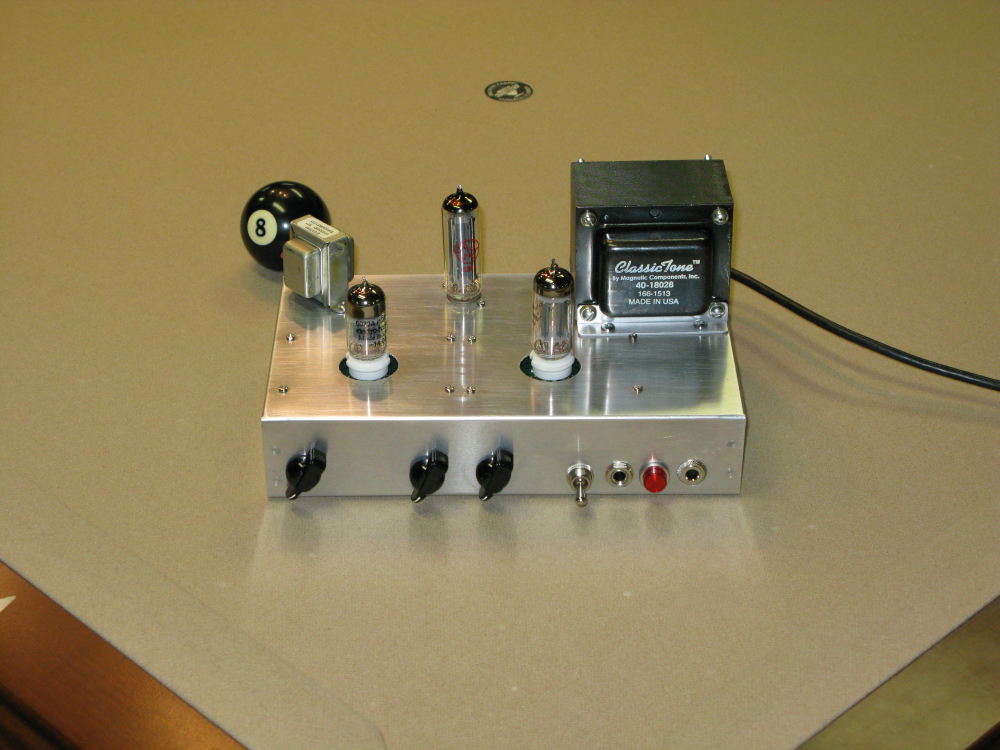
Front panel: Volume, Tone, Master Volume, Power Switch, Input Jack, Pilot Light and Headphone Jack. Tubes are 12AY7 preamp on the left, 12BH7A power tube on the right and EZ81 rectifier tube at center rear. ClassicTone 40-18028 power transformer at right rear. Fender 25000:8 3.5 watt Reverb Transformer used as the output transformer is at left rear. I violated Amp Cardinal Rule #1: I didn't put the power switch and pilot light on the opposite end of the chassis from the guitar input because of my placement of the two B9A circuit boards in the chassis.
Deluxe Micro #2 Combo Built by Jeff
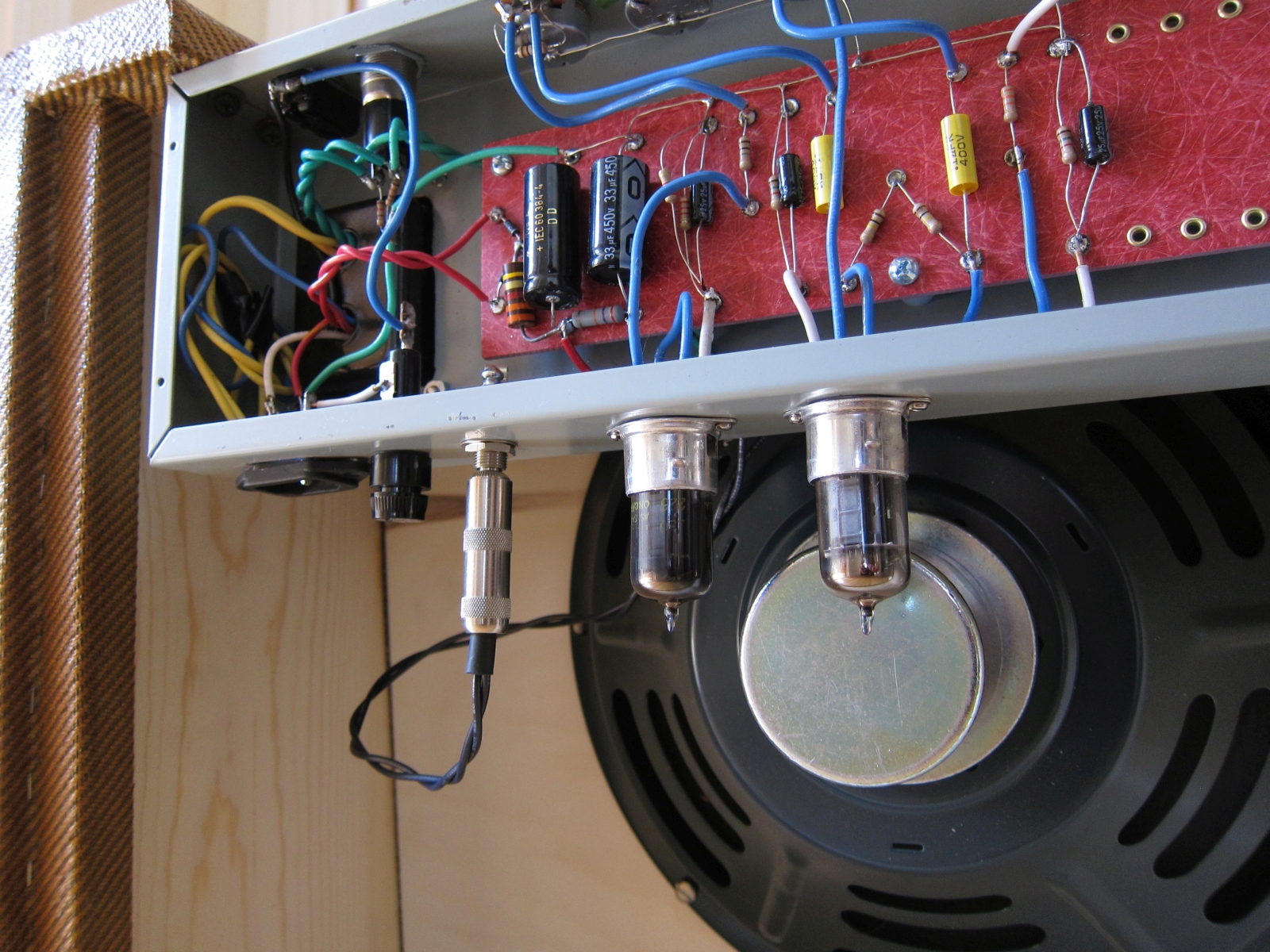
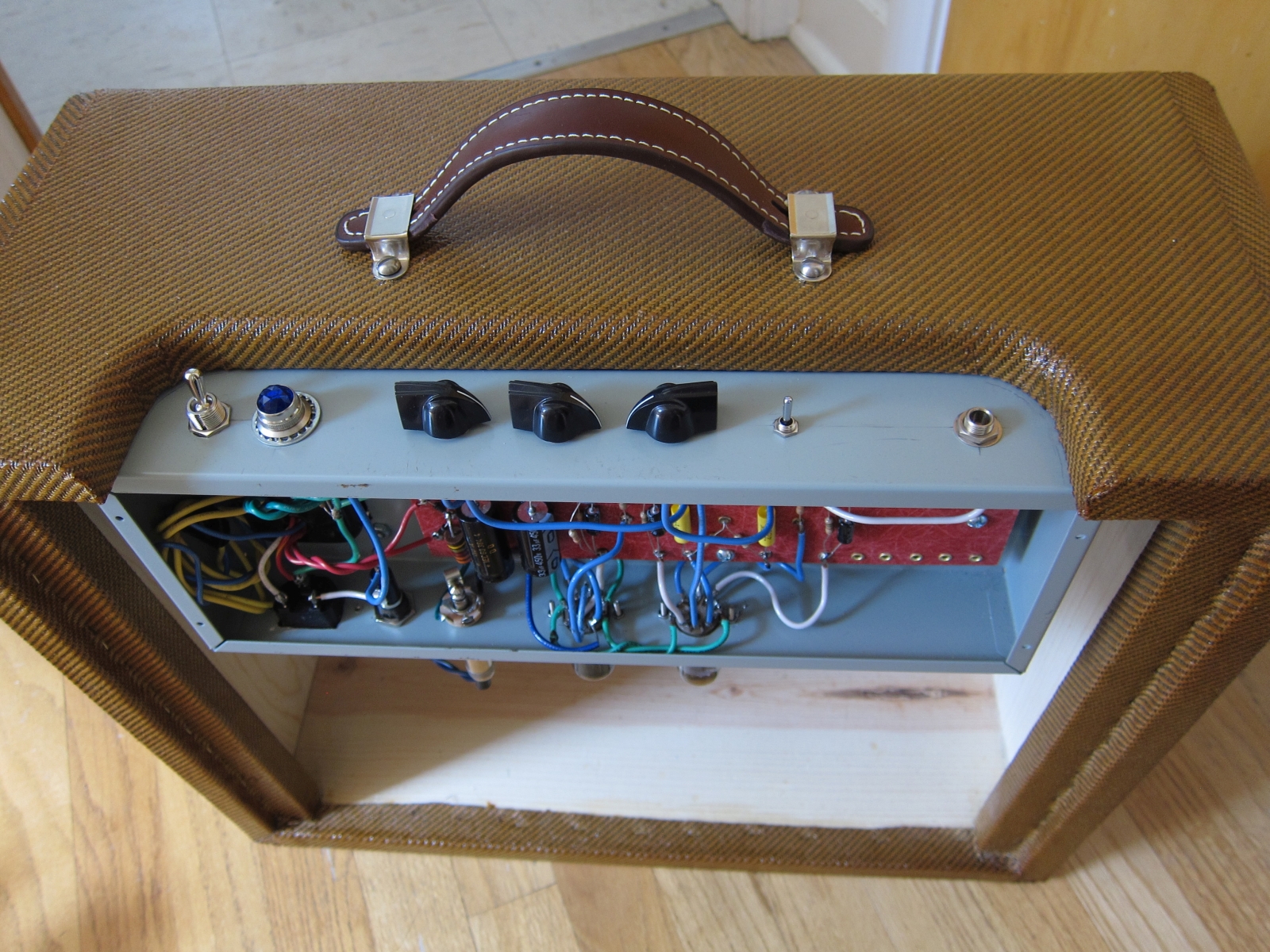
From the right: Input jack, Brite Switch, Volume, Tone, Master Volume, Pilot Light and Power Switch. Jeff went with the two tube, solid state rectifier option. Chassis was a 5E3 Deluxe blank and the cab is a standard 5E3. These pictures were taken before the chassis was painted.
Ty's Deluxe Micro #3 and Matching Cab
Deluxe Micro With Push-Pull Power Amp
The chassis is an old cable box.
Point-to-Point Build Using Tag Strips
Mark Doherty's Very Compact Deluxe Micro Build
Photo by Mark Doherty
Photo by Mark Doherty
Photo by Mark Doherty
Development
I get most of my parts from Mouser.com and TubesAndMore.com. Mouser for everything I can get from them and then TubesAndMore for everything Mouser doesn't carry like amp specific parts such as carbon comp resistors, tubes and tube sockets.
I hooked the Deluxe Micro's heaters to a dedicated 6.3V transformer then used a variac to control just the high voltage from a 375-0-375V transformer so I could vary the amp's B+1 voltage. I tried everything between 230 to 460V B+1. At 275V of B+1 I got 270V at the power tube plates and 103V at the V1 plates. With a low B+1 like this the amp looses some headroom and sparkle. The amp sounded great with a 460V B+1 with plenty of clean headroom, extra clarity and chime but pushing the power tube this hard will probably shorten its life.
For a solid state rectifier I believe the sweet spot comes from 250-0-250V of high voltage which gave me a B+1 of 390V, B+2 of 304, 150 and 146V on the V1 plates, 2.3 and 2.4V on the V1 cathodes; 375V on the V2 plate and 11.8V on the V2 cathode. I built my Deluxe Micro using an EZ81 tube rectifier and a 300-0-300V transformer gave 416v B+1 which is a little high so a 275-0-275V power transformer is perfect.
The amp pulls a total of 17 milliamps of B+ current using a 12AU7 power tube so if you need to drop the B+ voltage you can add a voltage dropping resistor between the rectifier and the first filter cap. You can lower the B+ voltage with about 58 ohms per volt. To drop 10v use a 560 ohm resistor which dissipates 0.18 watts so a 1/2 watt resistor is fine.
One of the last tweaks I did to the amp was to reduce the power tube cathode resistor from 2.2k to 820 ohms (2 watt to handle a 12BH7A) to warm up the bias and get more power out of the little 12AU7. The clean power jumped to 550 milliwatts and the max to 1.6 watts. The amp's tone also improved, it sounded more 'lively.' The bias increased to 100% of max dissipation which sounds perfect. I did try cathode resistors down to around 300 ohms but I got less clean headroom so 820 seems to be the cathode resistance 'sweet spot.'
You can upload this Deluxe Micro Hoffman Board file to the Hoffman DIYLC File Analyzer page and Doug will make an eyelet or turret board for you. The board will cost around $14 plus shipping.
My recommended power transformers when using a tube rectifier are the ClassicTone 40-18027 275-0-275V 100ma $64 with 120V-240V dual primary, 550 and 630V high voltage (use the 550V) 6.3v center tap and 5v output. The Hammond 290CAX 275-0-275V 115ma $62 will also work well. For international builders the Hammond 370BX available at Mouser has 100, 110, 120, 200, 220 and 240v primaries (see this for wiring instructions). Really any 190-0-190V (285V B+1) to 300-0-300V (430V B+1) transformer will work.
NOTE: If you use a Hammond power transformer you must add an artificial center tap to the two filament heater wires. Without a center tap you will measure very high heater voltage.
If you need a power transformer to fit in a 5F1 Champ chassis then the Mojotone MOJO759EX 290-0-290V will work well with a tube rectifier but would be too hot for a solid state rectifier.
When using a solid state rectifier I believe the sweet spot comes from a 250-0-250V power transformer.
Using my Firefly's Hammond 269EX 190-0-190v power transformer I only got a B+1 of 285V and the V1 plates were at 110V which is a little low. The Deluxe Micro sounded good but not as good as with a B+1 closer to 400V. If you do use the Hammond 269EX 190-0-190V $47 power transformer, I recommend you use solid state rectification and reduce the B+2 27K ohm 2 watt voltage dropping resistor to 22K to keep the V1 preamp tube's plate voltage up near optimum.
ClassicTone Reverb Transformer as Output Transformer
Red wire gets B+1 voltage, blue goes to the power tube plate (V2 pin 1), green and black connect to speaker jack.
The Hammond 1750A is also an option for the output transformer. If you want to try a 'better' output transformer than the $18 ClassicTone Reverb Transformer an optional upgrade is the Hammond 125ASE 3 watt $46 transformer (use black and orange secondary wires for 8 ohm speaker) but I tried both transformers and didn't hear a difference between them. You can also use the ultimate-- the Mercury Magnetics FBRONC-OM (4, 8, &16 ohm output, use the 4 ohm secondary wire for an 8 ohm speaker) from Weber for $100.
The 12AY7 and 12AU7 both use about 0.3 amps of 6.3v heater current. If you use an EZ81 rectifier tube it uses about 1 amp of heater current so any power transformer that supplies 2 amps of 6.3v for tube rectification will work, or 1 amp of 6.3v for diode rectification.
A simple four diode rectifier can be used to simplify construction. If you use a power transformer without a high voltage center tap you will need to use a four diode bridge rectifier instead of the diode rectifier shown in the schematics and layout diagrams below.
The preamp in all of the schematics and layouts on this webpage emulate the 5E3 Bright Hi channel. If you prefer the 5E3 Normal channel all you have to do to convert the preamp to Normal is remove the 470pF Bright cap from between the Volume and Tone pots. The Bright Cap only functions (bypasses high freqs around the volume control) at lower volume levels so it's usually preferred for lower volume playing. You can easily put the Bright cap on a switch so you can have both the Normal and Bright channels available.
The Speaker Jack has a 10 ohm 3 watt Headphone resistor across it to load the output transformer with an 8 ohm load when headphones from 32 to 600 ohms of impedance are used. The 10 ohm resistor is automatically disconnected when a speaker is connected. Be careful with the volume control when using headphones. Make sure it is at minimum volume when the amp is powered up and turn the volume knob slowly to keep from blowing out your headphones and ears.
One of the nice things about the design of the Deluxe Micro's power amp is its power tube flexibility. I have an Electro-Harmonix 12AY7 in V1 and a Tung-Sol 12AU7 in V2 and it just sounds great. I also tried an EH 12AT7, Tung Sol 12AT7, JJ 12AU7, Chinese generic 12AU7 and an EH 12BH7A for power tubes but the JJ 12AU7 and Tung Sol 12AU7 sound the best to me. I've heard great things about the long plate JJECC802S 12AU7 as a power tube so give it some consideration.
I was surprised the 7 watt 12BH7A didn't give any more clean power (0.66 watt) since it's rated at 7 watts compared to the 12AU7's 5.5 watts but it did bump the max output with distortion from 1.3 to 2.0 watts and it sounded pretty good. Reducing the bias resistor to suit this tube and dropping the plate load from 22k to 11k would most likely result in much more clean output power.
I also tried a NOS GE 12AV7 and it didn't work. I got a nasty, noisy distortion when the volume was above about 50%. I tried two of them and both had the noise problem.
Power Tube Comparison
| Tube | Cathode Resistor Voltage Drop | Plate Voltage | Plate-to-Cathode Voltage | Plate Current | Dissipation Watts | % of Max Dissipation | Clean Output Watts | Max Output Watts |
|
Tung Sol 12AT7W |
5.4 | 399 | 393.6 | 7.9 | 3.1 | 62% | 0.72 | 1.33 |
|
Tung Sol 12AU7 |
11.75 | 375 | 363.25 | 17.3 | 6.3 | 114% | 0.55 | 1.60 |
|
EH 12BH7A |
15.5 | 358 | 342.5 | 22.8 | 7.8 | 111% | 0.66 | 2.00 |
|
Tung Sol 12AX7 |
3.3 | 405 | 401.7 | 4.9 | 2 | 100% | 0.32 | 0.60 |
|
GE 12AV7* |
*BAD NOISE & DISTORTION |
|
|
|
|
|
|
|
Note: These voltages were with a 680 ohm power tube cathode resistor. The current design of the Deluxe Micro calls for a cooler running 820 ohm resistor.
The Tung-Sol 12AU7 is my current favorite power tube for the Deluxe Micro.
On an unrelated note, since the preamps of the Micro series amps are true tweed a preamp out jack might be a worthy option. All 3 amps can use the preamp out shown above in green in the schematic using a standard Switchcraft 12A jack. Just connect the Master Volume's output (pot wiper pin 2) to the jack tip terminal and connect the jack's switch terminal to the downstream grid stopper resistor. The Deluxe Micro's power amp will be disconnected when a plug is inserted to the preamp out jack.
I also did some more headphone listening and it works well for clean practice but I had to dial down the master volume for dirt because the volume was just too high. The headphones I used are efficient so a harder to drive set of cans would be more suitable for the Micro lineup.
Deluxe Micro Preamp (left) and Power Amp (right) Prototypes Using B9A Boards
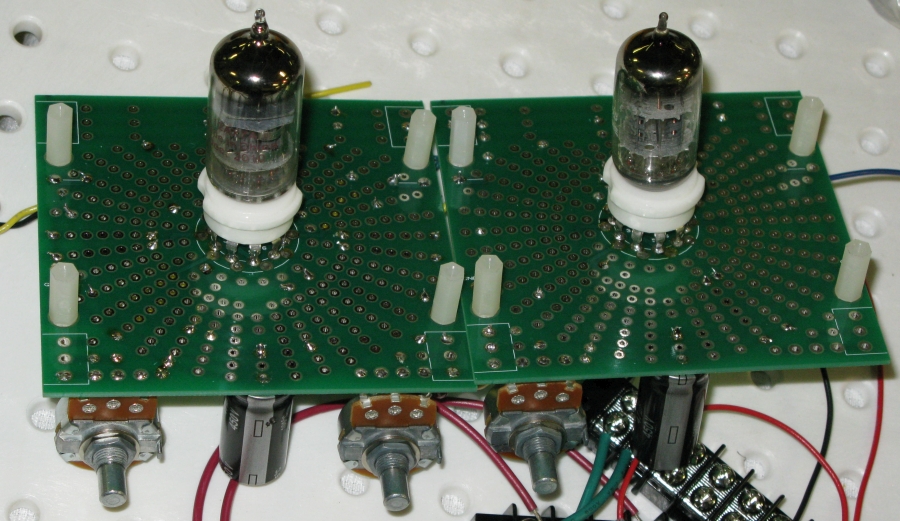
Tube side above, component side below.

This side of the board should not have tube sockets but I didn't read the fine print so I ended up with sockets on both sides of the boards. Note that you have to mount the tube socket on the side of the board marked "Fit tube this side"
Prototyping the Deluxe Micro
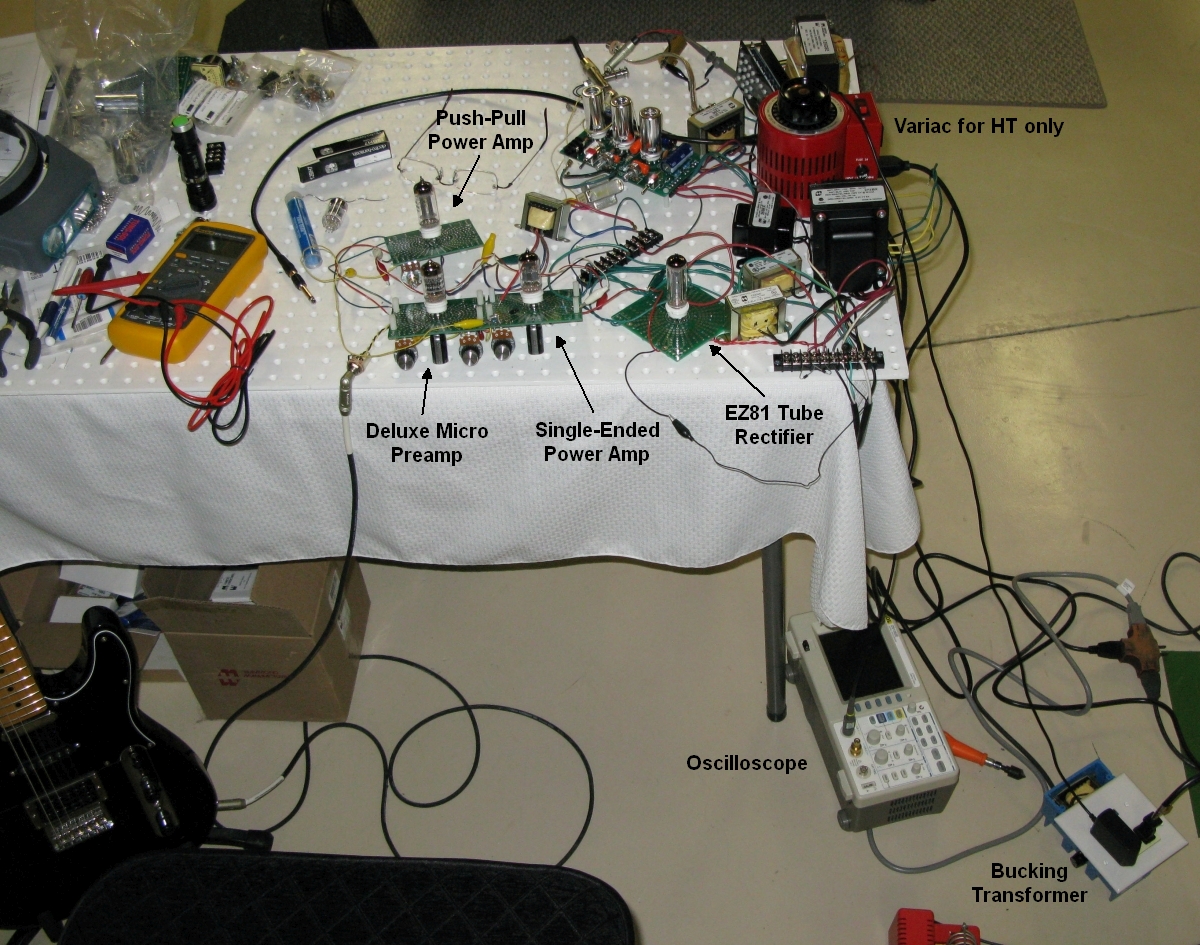
Deluxe Micro prototype on the prototype bench (to the right of the yellow multimeter). Red variac controls just the high voltage AC to the amp so I can fine-tune the required voltage. Separate 6.3V transformer supplies heater current. During the test and tweak phase of development I compared the Deluxe Micro to my 5E3 Deluxe, a Firefly micro amp (just left of the red variac) and an H&K Tubemeister 5. I played them all through a Weber 12A125A 12" Alnico speaker in an open back extension cab, a 15" JBL E130 with hemp cone and an Eminence 620H hemp coned 6" speaker in a small enclosure. The blue box at bottom right next to the oscilloscope is a bucking transformer used to lower the heater voltage to spec.
I added a Master Volume to the power amp because it's needed to control how hard the little power tube is driven. The Master Volume also does a good job of controlling the output for true bedroom amp volume levels. The Master Volume is also very helpful when pedals are used with the amp because you can keep from overwhelming the little power tube when using high output FX. At max Master Volume setting the Master Volume has no impact on the circuit--it's as if the Master Volume is not there.
The Deluxe Micro's Volume control works like a normal Deluxe, it will stay clean to around 3 or 4 on the dial then begin to breakup with preamp and power tube distortion. I like to start with the Master volume set to around 8 (out of 12) for maximum tweed. You need to play with the Master Volume to get the most out of this amp and to control the balance of preamp and power tube distortion. The Volume pot controls the preamp tube and the Master Volume controls the power tube. Some high output guitar pickups and effects pedals can push the power tube too hard and cause some funky power tube distortion. If this occurs just dial back the Master Volume a little.
When you want to really turn up the overdrive try a 12AX7 in V1. The Deluxe Micro handles a 12AX7 in V1 well because the Master Volume can keep the little power tube from being overdriven into oblivion. I'm really surprised all micro amps don't have a Master Volume, it really is necessary to make a small amp versatile.
Builder of Deluxe Micro #4, Ty Crow, used a 6N2P Russian triode tube as a 12AX7 substitute in the preamp. He says it sounds good. All he had to do was run the 6.3v heater wires directly to pins 4 & 5 (one wire each) and leave pin 9 empty.
If the Deluxe Micro is still too loud for your practice sessions you can reduce the power output by deleting the 25uF 25V power tube bypass capacitor. You could easily put the bypass cap on a switch.
I played the Deluxe Micro through three different speakers during testing: My favorite Fender tweed era speaker is the Weber 12A125A 12 inch Alnico in an open back cab. The little Deluxe Micro sounded best with this pairing--very rich and tweedy and it made my Telecaster sound like a Tele should. The 12A125A is a low efficiency speaker rated at 97dB but the Deluxe Micro still put out plenty of volume at high Master Volume settings.
I also tried my favorite small speaker, an Eminence 620H 6 inch hemp coned speaker. If you need lower volume this little speaker is the way to go. It still sounds very good with less of everything compared to the Weber but max volume is quite a bit lower.
Finally I hooked up my 5E3P Proluxe's 15 inch JBL E130 hemp coned speaker to the Micro. It's a very high efficiency (105 dB) driver that pumps out loud, clear, accurate guitar tone. The Deluxe Micro was crazy loud and sounded fantastic. I really had fun with this speaker for high distortion shredding with a 12AX7 in V1 but it was loud enough that my wife had to intervene. I recommend you go with an 8" or larger speaker because this amp sounds too good to be strangled by a 6" speaker. Bottom line is any speaker that works with a full size 5E3 Deluxe should work well with the Deluxe Micro.
I compared the Deluxe Micro's tone to my Firefly micro amp (single self-split push-pull 12AY7 power tube) and H&K Tubemeister 5 (single-ended 12BH7A power tube). The biggest difference in tone is the Deluxe Micro's 5E3 low end. It's always there no matter how hard you shred the little amp, while the Firefly and Tubemeister scream with modern high pitched accuracy. You could really hear the difference between the two amps through the big 15" JBL but the Deluxe Micro blows away the other amps when playing clean through the Weber 12A125A 12" alnico.
For the most authentic 5E3 Deluxe tone I highly recommend Weber Alnico speakers. Their Vintage and Signature Alnico speakers drip authentic Fender tweed tone. They offer two lines in sizes from 6 to 15 inches. I personally love my Weber Vintage 12A125A ($104) but people really like the Signature line that runs at about half that price and $55 is crazy low for a 12" Alnico speaker. The $999 Fender Eric Clapton Vibro Champ comes with an 8 inch Weber Signature Alnico.
For ultimate convenience building a small combo amp paired with an 8 inch speaker is probably the way to go but be sure and try the Deluxe Micro with other speakers so you can really appreciate how good it sounds with a real, full sized tweed speaker.
If you like to mod your amps many of my 5E3 modifications apply to the Deluxe Micro. If you decide to add tube reverb I recommend you tap the signal at the volume pot output.
Using the Deluxe Micro As a Tube Tester
The Deluxe, Champ and Bassman Micro's can use the same power and preamp tubes so all three tweed Micro amps can function as a preamp tube tester. If you do plan to use the amp as a tester then try to match V1's 100k load resistors and 1.5k cathode resistors so you can take bias readings of the two halves of the tube to check for balance between the tube's two triodes. Balanced triodes are important for long tail pair phase inverters or push-pull power micro amps. You also want to measure and record the exact values of the two cathode resistors for precise bias measurements.
Insert the tube to be tested into V1 and power up the amp. To read the bias of V1A and V1B make sure the input jack does not have a guitar plugged into it, turn the volume up to 11 (we're trying to match V1B to V1A's 33k grid stopper) and turn the Tone to 12. Set your multimeter to read DC Volts and place its probes on each leg of the cathode resistor. The voltage drop across resistor will be shown so record it. If the voltage is negative just ignore the sign. Then place the black probe on a ground and touch the red probe to V1's pin 1 to measure V1A plate voltage and record it. Place the red probe on V1's pin 6 to measure V1B's plate voltage and record it.
With these numbers we can now calculate the tube's bias. We need the Plate-to-Cathode voltage so subtract the cathode voltage from the plate voltage and record the numbers. Then use my Tube Bias Calculator webpage to do all the calculations. As an example we'll say the measured cathode voltage drop was 2.3 volts and the plate voltage was 150. We subtract the 2.3v from 150v and get 147.7 plate-to-cathode voltage. We go to the calculator and select our tube type of '12AY7' and you'll see it's rated for 1.5 watts per triode. We then plug in our plate-to-cathode voltage of '147.7'. Move down to the next section, Tube Dissipation Using Cathode Resistor Voltage Drop, and enter the number of tubes that share a cathode as '1' because V1A and V1B have separate cathode resistors. If you were testing using V2 then you would enter '2' because V2A and V2B share a cathode resistor. Next enter the cathode resistor voltage drop of '2.3' and then the measured resistance of the cathode resistor of 1522 ohms. Press any Calculate button and our answer is shown in the triode line that states, If your tube is a triode then there is no screen current so your plate current is 1.5 milliamps, your plate dissipation is 0.2 watts and 13.3%. You would do the same for the other triode and compare their numbers--the closer the bias is between the triodes the better the balance.
Below I offer up layout diagrams for a traditional eyelet board, point-to-point wiring and ValveWizard B9A development board PCB's.
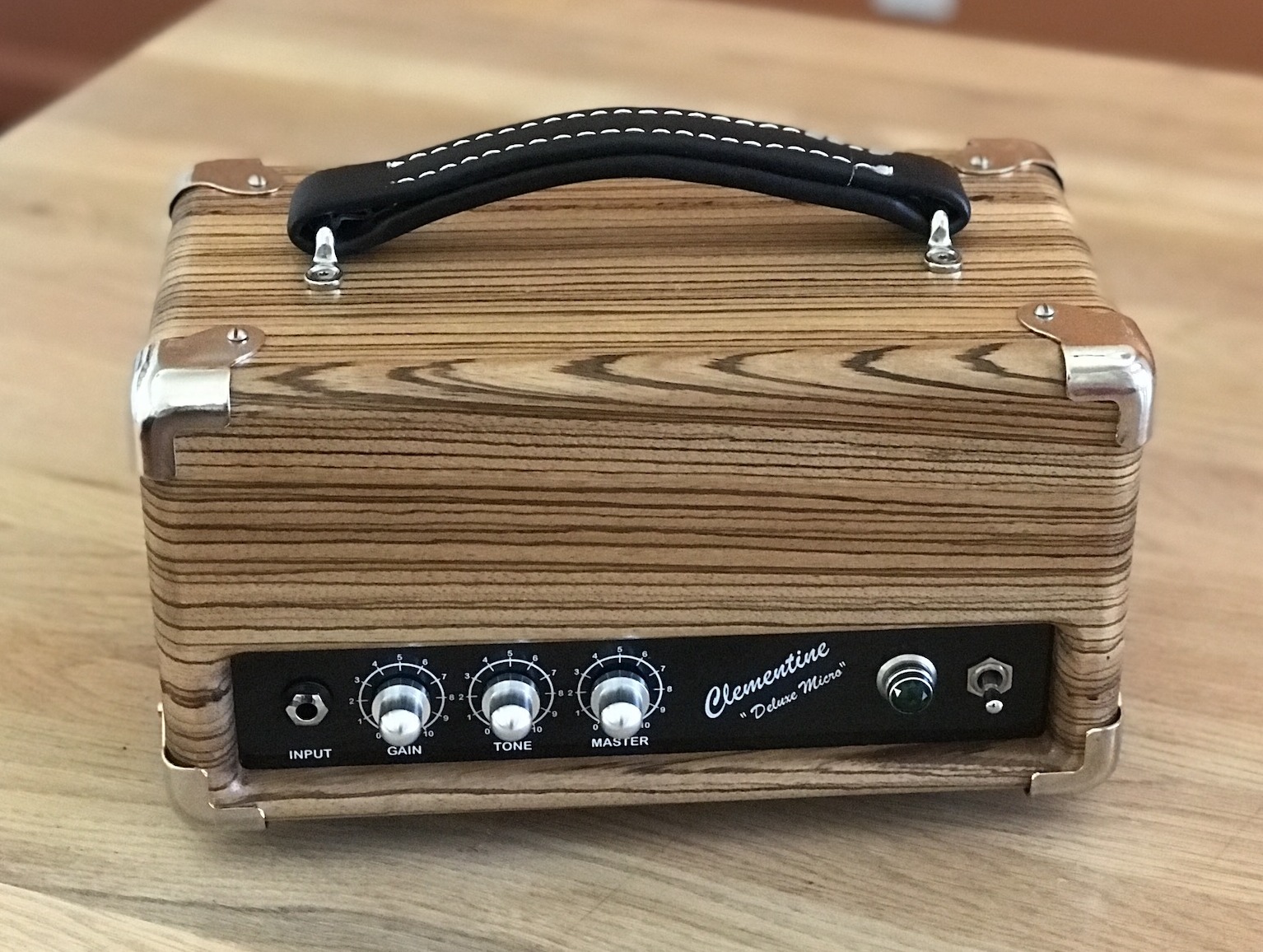

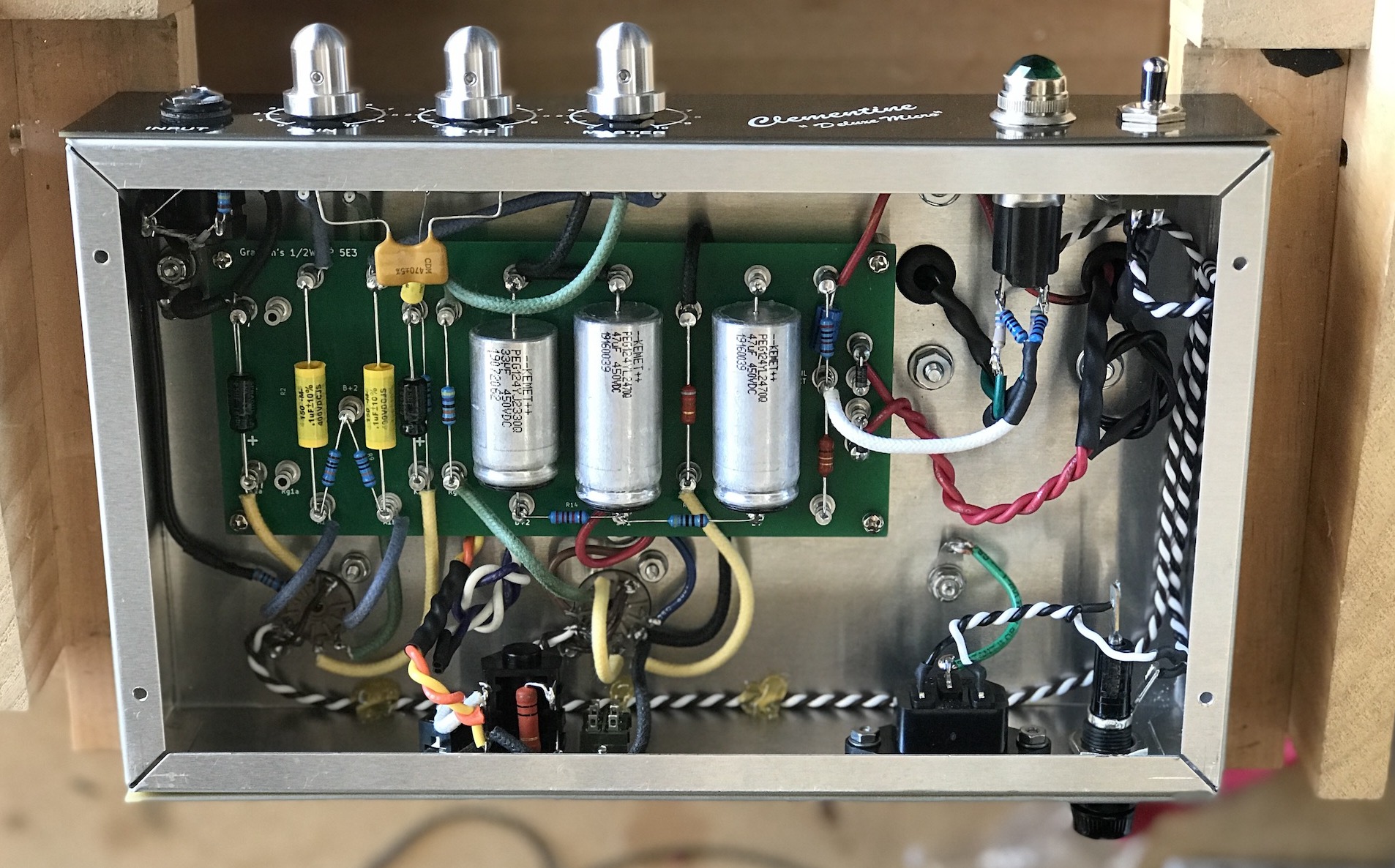
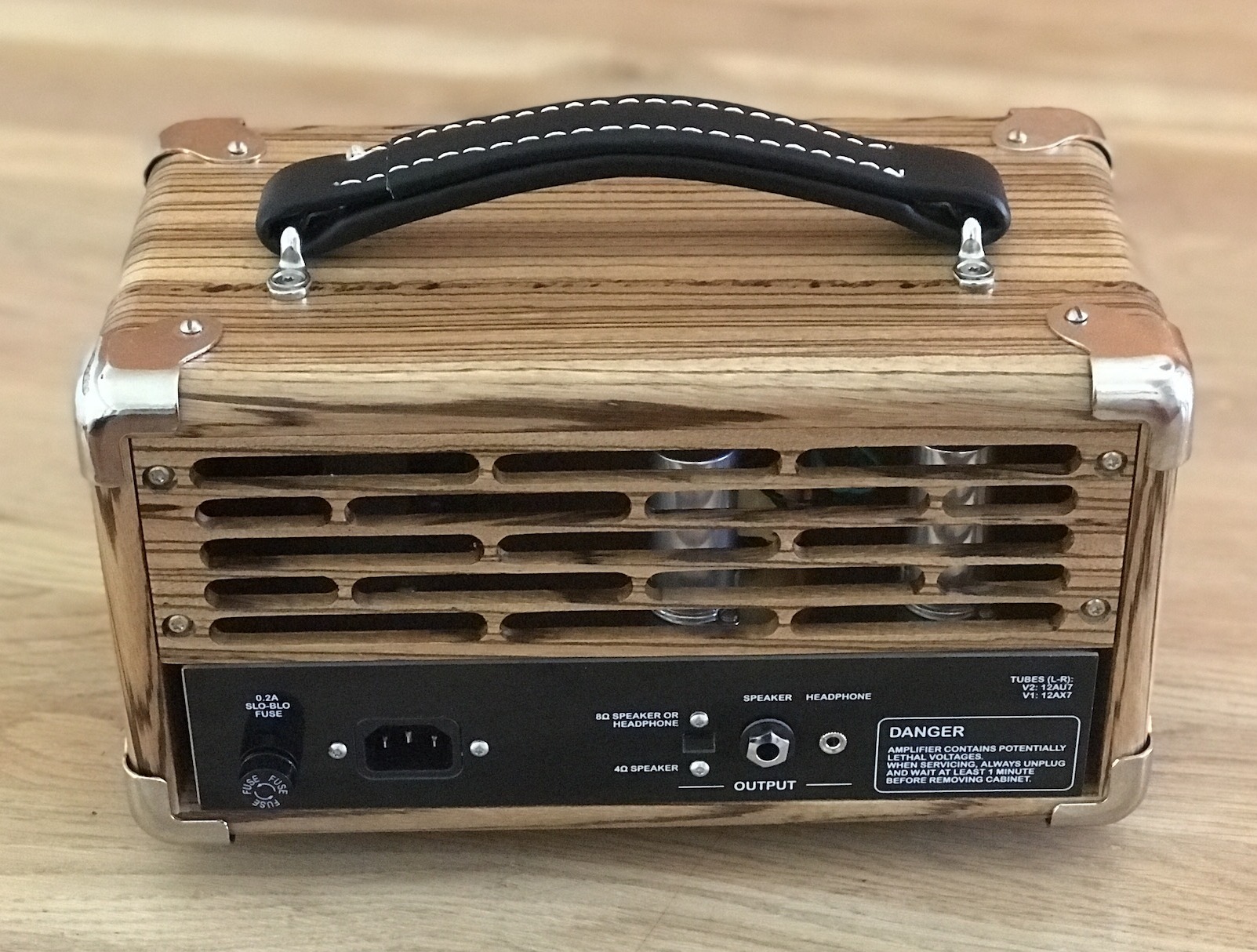
Layout Diagrams
Eyelet or Turret Board Layout with Two Rectifier Options
Both tube and solid state rectifiers (far left of circuit board) are shown--choose one. I separated the V1B cathode resistor and bypass cap to facilitate a negative feedback switch mod. Click image to view the hi-res PDF layout. Download the DIY Layout Creator file here.
The EZ81 rectifier tube uses a standard 9-pin socket and 6.3V filament heat so no 5V power transformer output is needed. If your power transformer does have 5V available and you'd rather use a standard 8 pin rectifier tube like a 5Y3GT then just wire the 8 pin socket with the high voltage AC to pins 4 and 6, 5V heater lines to 2 and 8 and the B+ power line to pin 8.
Point-to-Point Wiring Layout
Click image to view the hi-res PDF layout. Download the DIY Layout Creator file here.
Three Terminal Tag Strip

These tag strips are great for point-to-point wiring. Keep in mind the middle terminal will be grounded to the chassis unless you isolate the strip from the chassis and bolt. If you plan to use the middle terminal as a ground be sure and clean the chassis around the bolt and use a star washer between the chassis and tag strip for a good chassis ground connection.
Building the Deluxe Micro
I get most of my parts from Mouser.com and TubesAndMore.com. Mouser for everything I can get from them and then TubesAndMore for everything Mouser doesn't carry like amp specific parts such as tubes, sockets and period correct (and cool looking) carbon composition resistors.
This 5F1 Champ chassis designed for EL84 (9 pin power tube) will work great for the Champ or Deluxe Micro.
This is the general build sequence I recommend:
Start with the circuit board, either eyelet, turret, B9A development board or even perfboard. The circuit board should be at least 6 3/4" x 2 3/4" by 1/8" thick.
I like to measure and record the resistance value for all the resistors as I put them on the circuit board. Knowing the exact resistance value can come in handy when measuring bias and troubleshooting and it can keep you from putting a 470 ohm resistor where a 470K is called for.
Install the rest of the components to populate the board but don't start soldering until they are all in place and you're sure they are placed correctly. This is a good time to post a pic of the board on a guitar forum for others to review. I like the TDPRI Shock Brothers DIY Amps forum (I'm robrob). Make sure the negative terminals of the big filter capacitors are connected to ground because they may explode and damage the output transformer if installed backwards. Most filter caps have an 'indention' on their positive end and arrows pointing to the negative end. Remember to leave the turret top holes available for leads that run from the turret to the tubes, controls and jacks. I use the '3/4 lead wrap around the turret' method which is old mil spec. Install tube, jack and control wires and leave a couple inches of extra wire so you can trim to fit later.
22 gauge wire is fine for all the amp's wiring including the heater wires. I recommend you connect the 6.3V filament heater wires from the power transformer directly to the rectifier diodes or tube, then split two wires from there: a wire to the pilot light and one to V2 and V1. For wire color I like to use yellow for the signal path, red for power, black for ground and green for heaters. This is a good time to post another pic of the board on a guitar forum for others to review.
You need a good quality soldering iron with a clean, pre-tinned tip to successfully solder eyelets and turrets. Frequent tip steam cleanings using a damp sponge will keep your solder joints looking good. When soldering eyelets I like to use a little flux paste on the eyelet and the component leads because it really helps the solder adhere for a good, long term connection. I just dab a little on the join using a thin artist paint brush. Chasing a cold solder joint can be a colossal pain in the butt.
When soldering turrets keep in mind they are pretty good heat sinks so you need to apply soldering iron heat to the turret for a 5 to 10 seconds before making contact with the component leads. This will keep you from frying components as you wait for the turret to get hot enough to bond with the solder. Speaking of frying components, it's a good idea to use a heat sink clamp on component leads--especially capacitor leads--to protect the component. Even just an alligator clip on the component lead between the soldering iron and component body will protect it from overheating.
The 5F1 Champ chassis is a tight fit for the circuit board so I recommend a blank 5E3 chassis but you'll have to drill and punch all your holes. You could use a drilled 5E3 chassis and use the extra holes to mount switches for mods like switched negative feedback and a bright switch. You can always use a normal, 8 pin sized 5Y3GT as the rectifier tube since that size hole is already available. This is probably the easiest way to go because there are so many 5E3 combo cabs and head cabinets available. You can also go with a 'table top' style chassis that could easily be installed in a small cab. Hammond sells an aluminum 1444-16 10" x 6" x 2" blank chassis that will be roomy but you will have to drill your own tube holes using a step drill bit or hole punch.
Mount the tube sockets, pots, fuse, power switch, pilot light and transformers in the chassis and do as much wiring on these as you can before you mount the circuit board because it will get crowded in the chassis. Be sure and solder any wires that run under the board before installing it so you don't have to try to fish a wire under the board. Don't solder the output transformer's leads until after verifying the negative feedback is not causing positive feedback squeal. I recommend you follow my Amp Startup Procedure so don't solder the output transformer's leads until the procedure says to. Don't forget to do the heater wires first, before you install the circuit board and begin hooking up the other tube leads. Try to keep the tightly twisted heater wires down against the chassis floor to reduce noise and hum.
ClassicTone 40-18027 Power Transformer for Solid State Rectifier
For 120V wall power connect the transformer's black and brown wires to the power cord's Hot-black-narrow prong wire, and connect the transformer's black/white and brown/white wires to the power cord's Neutral-white-wide prong wire. For 240V wall power connect the black/white and brown wires together (solder and insulate). The transformer's black wire connects to the power cord's Hot-black-narrow prong wire. The brown/white wire connects to the power cord's Neutral-white-wide prong wire. Connect the power cord's green safety ground wire to a transformer mounting bolt. For output power to the rectifier use the red/white wires for 550V (275-0-275V) of high voltage. The two green 6.3V wires go to the pilot light and all tube heaters. Note the EZ81 rectifier tube has non-standard heater pin numbers. The red/yellow and green/yellow center tap wires connect to the negative terminal of the B+1 Filter Capacitor.
ClassicTone 40-18028 Power Transformer for Tube Rectifier
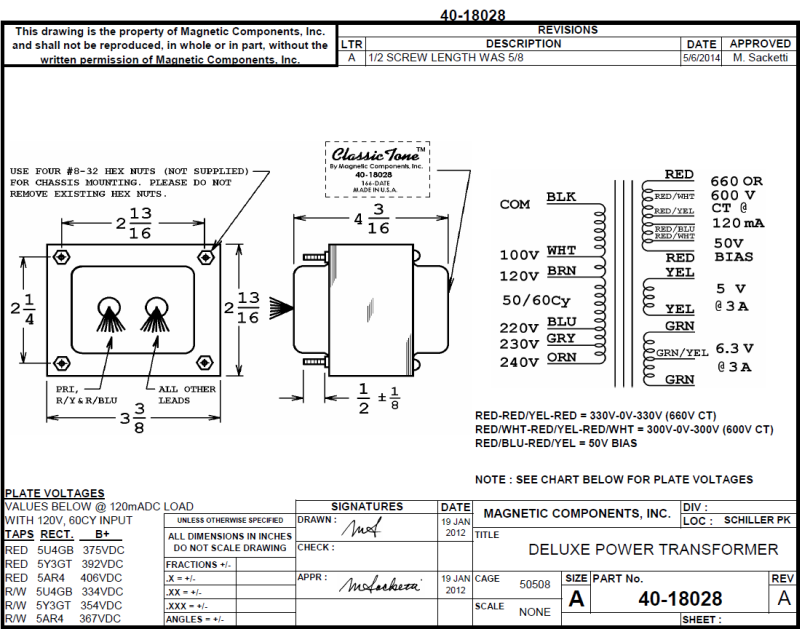
For 120V wall power connect the transformer's black wire to the power cord's Hot-black-narrow prong wire, and connect the transformer's brown (not white!) wire to the power cord's Neutral-white-wide prong wire. Connect the power cord's green chassis safety ground wire to a transformer mounting bolt. For output power to the rectifier use the red/white wires for 600V (300-0-300V) of high voltage. The two green 6.3V wires go to the pilot light and all tube heaters. Note the EZ81 rectifier tube has non-standard heater pin numbers. The red/yellow and green/yellow center tap wires connect to the negative terminal of the B+1 Filter Capacitor. Trim, insulate and tuck the other transformer wires out of the way. I chose to leave all the transformer wires at their full length so I can easily use this transformer in a future project.
240 Volt Primary Wiring for Hammond 370BX
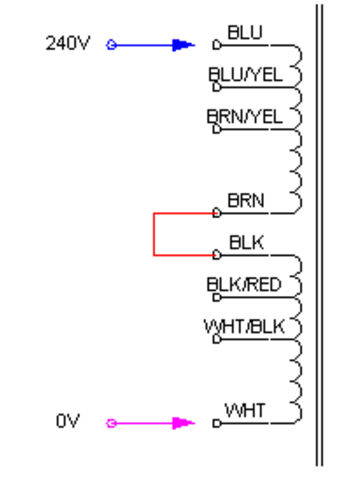
International builders should use the Hammond 370BX with 100, 110, 120, 200, 220 and 240v primaries. Don't forget to connect the Brown and Black wires together.
Power Cord Wiring
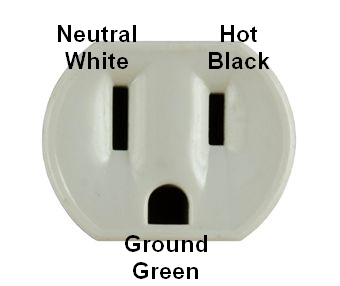

Modern U.S. wall cords and sockets have a narrow blade for Hot (black wire 120v), a wide blade for Neutral (white wire ground), and a round or 'D' shaped prong for the chassis Safety Ground (green wire ground--the Neutral and Safety Ground are connected at the main circuit breaker box). Wire colors are sometimes non-standard so use a multimeter to identify Hot and Neutral.
Install the circuit board and connect all the leads. Post detailed pics for forum review before applying power. I recommend you follow my Amp Startup Procedure. Following it can prevent damage from a mis-wired amp. If you have a light bulb current limiter you should use it for the startup.
My power transformer is rated at 300-0-300 volts AC RMS but I measured 328 volts on each wire at the rectifier input due to my high wall voltage of 125.3V. Yes, that is 660 AC volts measured wire-to-wire so be careful when measuring live voltage in this amp. It's a teeny-tiny amp but it uses big amp voltage.
Measured Voltages
Power Transformer Output 328-0-328 (656) volts AC.....This is the only AC measurement, everything else is DC
B+1 400V DC.....................................................................Measured at the rectifier output--measured 417V so I added a 220 ohm 1 watt voltage dropping resistor to get down to 400V B+1.
B+2 304V...........................................................................Measured after the 27K voltage dropping resistor
V1A Plate (pin 1) 150V
V1A Cathode (pin 3) 2.3V
V1B Plate (pin 6) 146V
V1B Cathode (pin 8) 2.4V
V2 Plates (pins 1 and 6) 390V
V2 Cathodes (pins 3 and 8 to ground) 7.4V
Cathode Resistor 14.8V across the resistor
The amp pulls a total of around 30 milliamps of B+ current at idle using a 12AU7 power tube.
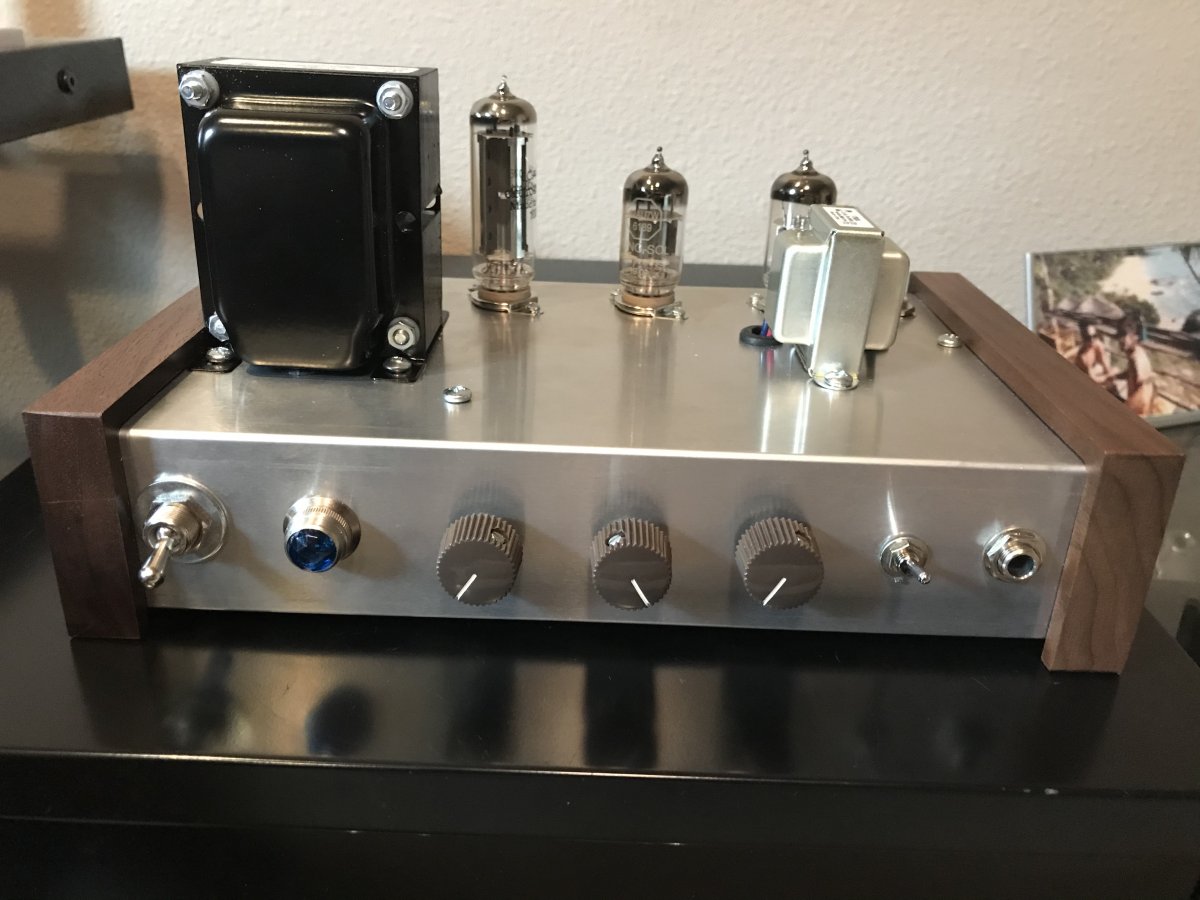
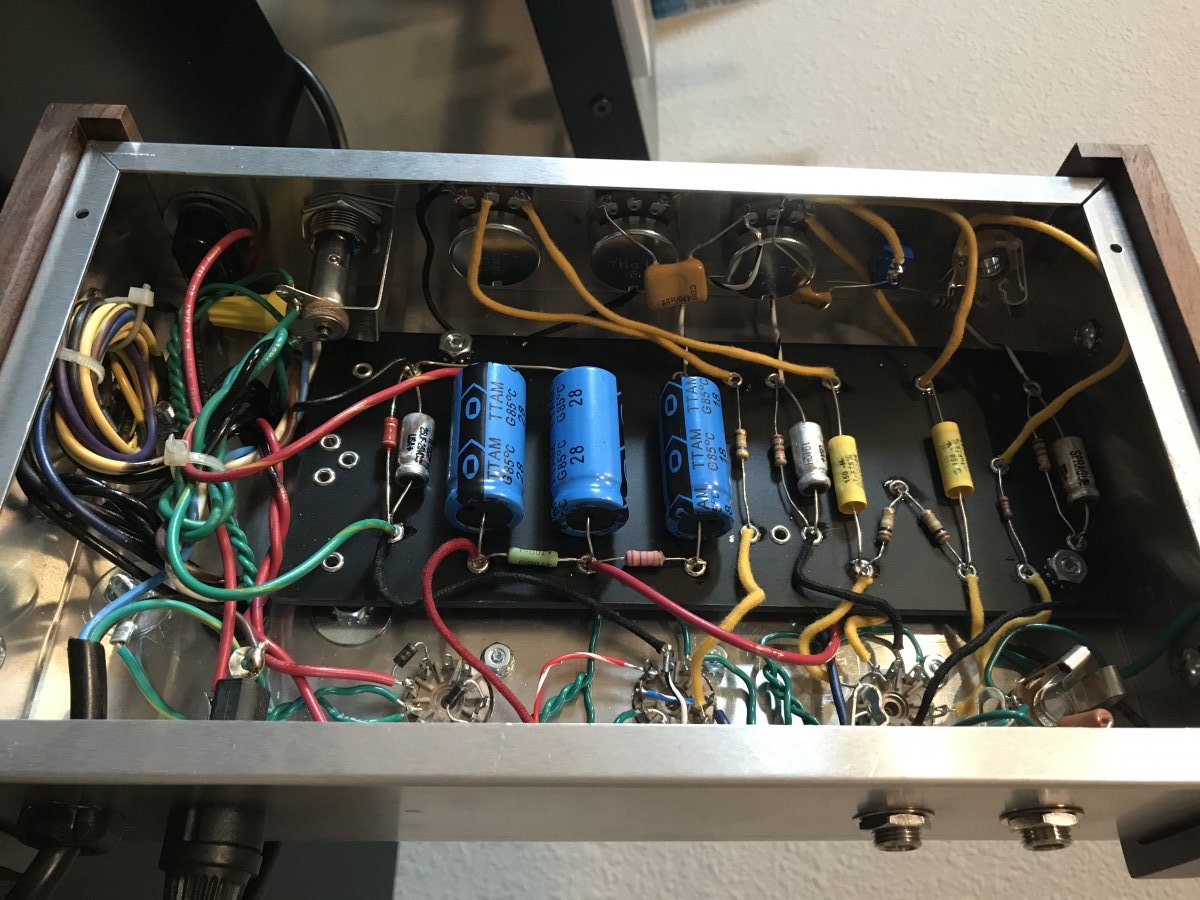
Optional Line-Out Jack
The Matchless Spitfire Line Out jack gets its signal from the 8 ohm speaker jack's tip terminal and the 22K ohm and 3.3K ohm resistors form a voltage divider to lower the signal voltage to line out levels. Of course the amp's output volume control will control the Line Out volume too--which brings up an important point. A speaker must be attached to the amp's speaker jack when using the Line Out to prevent output transformer damage. This tiny little circuit cannot load the transformer properly to run speakerless.
If you are cramped for space for an additional jack you can use your amp's 'extra' speaker jack or even add a small 3.5mm (mp3 player size) jack to save room. To convert the extra speaker jack replace the tip-to-tip green wire with the 22K resistor and add the 3.3K resistor.
Simple Line-Out Jack
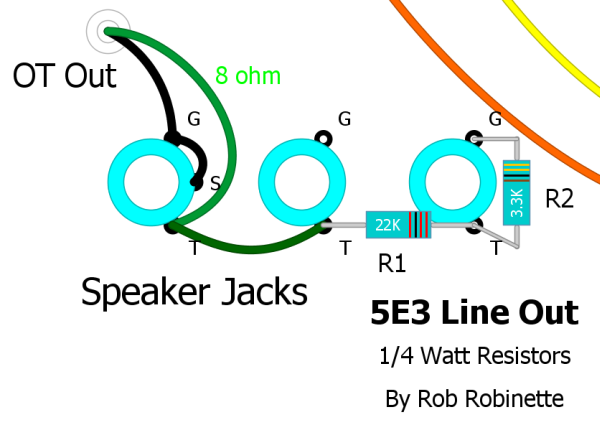
The resistors form a voltage divider and attenuate the speaker signal by 86%.
Brighten the Deluxe Micro for Humbucker Guitars
Humbucker pickups pass a lot of low frequency energy to an amplifier so they tend to sound darker than single pickup guitars. The easiest mod to make any 5E3 work better with humbuckers is to reduce the size of the V1 cathode bypass cap from 25uF down to 1uF (25v or higher). This will trim some of the excess bass from the humbucker pickups which will brighten the tone. If your single pickup guitars sound too bright after the mod just roll off some highs using the guitar or the amp's tone control.
Chasing Down a Nasty Buzz
After I finished testing and tweaking the Deluxe Micro prototype in bare circuit boards I mounted them in a Hammond 1444-16 10" x 6" x 2" blank chassis. When I fired up the newly mounted amp I had a nasty buzz at max volume. It didn't sound like 60Hz heater wire hum or 120Hz power supply ripple hum so the investigation began.
The amp with no guitar cable plugged in was absolutely silent at max volume. The buzz could be controlled by both the volume and master volume controls. The amp's tone control could almost entirely eliminate it when turned full down. The guitar's tone control could completely eliminate the noise when turned full down. Hmmm. The buzz didn't change with guitar movement or when touching the guitar's grounded metal bridge.
Since the volume control affected the noise I knew it was entering the amp before the control--somewhere between the guitar and the volume pot.
My first instinct was I had a bad cable or a guitar issue. I tried another cable--no change. I tried my Strat--no change. I tried a cable with no guitar connected and got the expected crescendo of noise.
My next suspect was the fluorescent lights that light the basement workshop. I turned them off and the amp looked cool in the dark as it spewed forth The Buzz.
Maybe it was power line noise. I diligently moved the amp to another part of the house and tried--no change.
Time to get into the chassis. My first thought was a bad ground connection so I alligator clipped a wire to the chassis and carefully probed all the ground connections in the amp to see if I heard an improvement but found no success.
My next step was lead dress. I used a wooden chopstick to push around wires while listening for an improvement in noise. I did find that the input jack wires that ran by the power switch and across both circuit boards were picking up some 60Hz hum from the power switch. I replaced the input jack and headphone jack wires with RG174 coax which eliminated the hum but had no effect on The Buzz.
Time for the oscilloscope. I started with the input jack, zoomed in on the signal and played with the guitar tone control to change the volume of The Buzz but couldn't see any signal artifact change with the guitar tone change. I jumped to the speaker output jack and tried again with no success. Next I tapped into V1A's output just after the coupling cap (to avoid high voltage DC on the probe) and repeated the tone change and again I couldn't see any change on the oscilloscope. I moved the scope probe to V1B's output and repeated the guitar tone knob dance--and there it was. A vertical spike that grew and shrank with the tone control's movement. I zoomed in the scope's display and confirmed it was THE BUZZ.
I used the scope's horizontal scan knob to move the waveform left and right so I could measure the time between spikes--17.4 milliseconds. Off to the internet to convert the time interval to frequency and the answer was--60Hz, it was wall power related after all, or so I thought. I pulled out my trusty H&K Tubemiester 5 and plugged it into the same power socket and fired it up--no buzz. I figured the H&K might have some power line filtering built in so that test proved nothing.
I have seen some amps with a .01uF 3KV (3000V) disk capacitor across the rectifier tube socket's high voltage input pins to pre-filter high freq noise so I gave that a try. It did help a little but THE BUZZ still lived.
I sat there staring into the amp's chassis wondering what it could be. I noticed the 120V pilot light (not a standard 6.3V light) sitting next to the input jack. This was my first build using a 120V light so I had no experience with them. I hauled the amp back to the solder station and de-soldered the light's neutral wire and fired up the amp--success! THE BUZZ was no more. It was that damn noisy bitch of a pilot light.
The fact that the amp was silent when no guitar cord was plugged in was a big clue here that I missed. With no cord plugged in the circuit from the input jack to V1A's grid is grounded so THE BUZZ was being shunted to ground. I should have focused the investigation on the input circuit from the start. 20/20 hindsight and all that. . .
When I stuffed the prototype B9A boards into the chassis I put them to the far left with the plan to mount the power transformer on the far right. After getting the boards mounted I realized I had no front panel real estate on the left side of the chassis. I ended up having to mount the power switch, pilot light, guitar input and headphone jack right next to each other--which is not good--it's a cardinal sin of amp building actually and I had to pay a penance to atone for my sin.

Notice the power switch, input jack, 120v pilot light and headphone jack. Not a good idea. If possible keep the power switch and light on the power transformer end and put the input jack on the preamp end of the chassis.
The little prototype is now nice and quiet and just sounds killer.
How the Deluxe Micro Works
For a non-technical primer on how guitar tube amplifiers work see my How Tube Amps Work web page. If you have trouble understanding this section I suggest you go back and read this primer.
5E3M Deluxe Micro Signal Flow
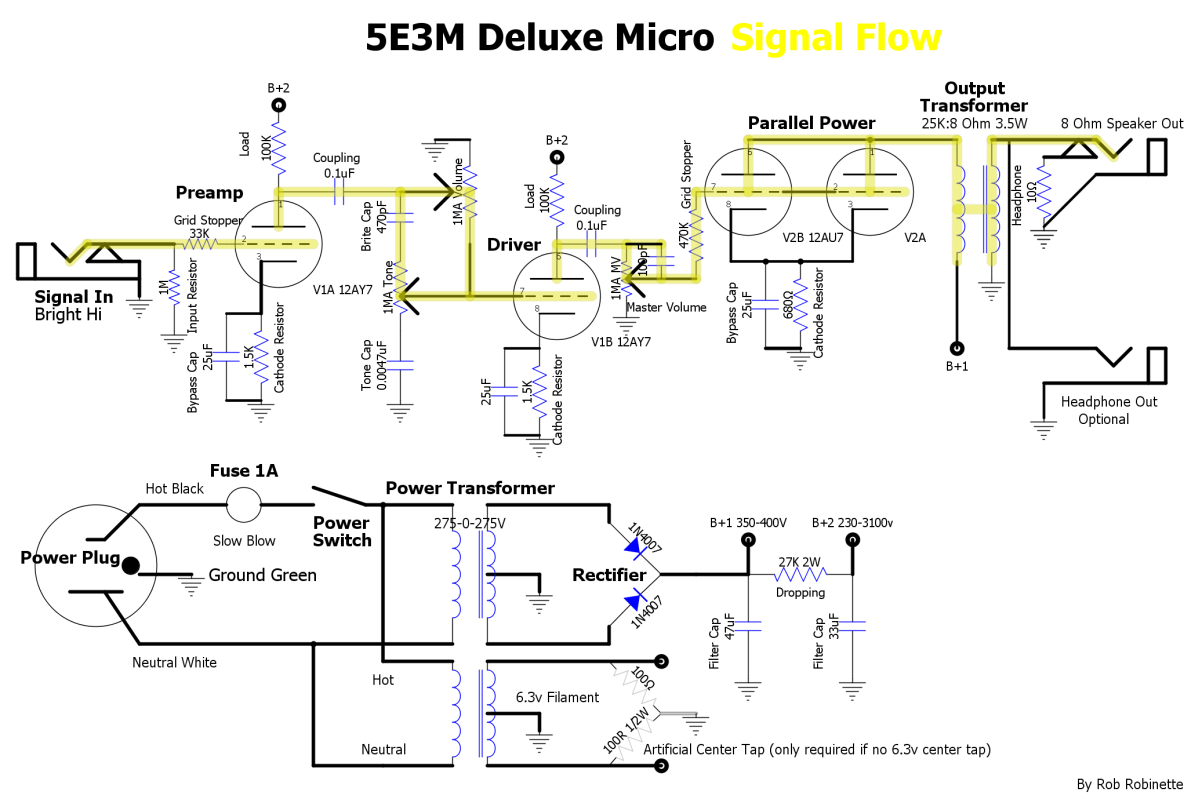
Signal flow shown in yellow highlight. The guitar signal enters at the input jack at upper left. Flows through the grid stopper resistor to the V1A (Valve 1, first half) grid for its first stage of amplification, out the plate through a coupling cap to the bright cap and volume control. The bright cap bypasses high freqs around the volume control to the tone control. The tone and volume controls' outputs send the signal to the V1B (Valve 1, second half) grid for more amplification, out the plate, through a coupling cap to the master volume control. Another bright cap bypasses some high freqs around the master volume to the power tube (V2) grid stopper and both V2A and V2B grids for its final stage of amplification. The signal leaves V2 via its plates and flows through the output transformer to the speaker jack and speaker.
The low voltage alternating current (AC) audio signal from the guitar's pickup coils enters the Deluxe Micro at the Input Jack. Typical signal level from the guitar pickup coils is about 0.1 volt rms but can vary greatly due to the number of pickups, their design and of course how and what is played on the guitar.
The first component the guitar signal encounters is the 1 megaohm Input Resistor. It supplies a return path for the guitar coil's current--it allows current to flow from the guitar cable's tip, through the Input Resistor, to the guitar cable ground conductor. The Input resistor supplies an intentional impedance mismatch between the guitar and amp called impedance bridging. Impedance bridging just means the guitar's and amp's impedance match up correctly for optimum voltage signal transfer (low impedance guitar, high impedance amp). The Input Resistor also functions as the grid leak resistor for tube amplifier stage V1A (valve 1, first half of the tube). A grid leak resistor 'leaks' off unwanted DC (direct current) voltage on the tube's control grid to keep the grid at 0 volts DC. The Control Grid needs to stay at 0 volts to keep the tube bias correct.
After the Input Resistor the signal encounters a 33 kilo ohm Grid Stopper resistor. The Grid Stopper filters out audio signals above human hearing which helps stabilize the amplifier and prevent it from oscillating. After the Grid Stopper the signal hits Tube V1A's Control Grid, pin 2 in the schematic above (our 12AY7 preamp tube is actually two tubes in one--a twin triode--and V1A means 'Valve 1, first triode). V1A is called a triode because it has three electrodes (control grid, cathode and plate, a tube with a fourth, screen grid electrode is called a tetrode and a pentode has a fifth, suppressor grid electrode).
The Control Grid is the 'valve' or gate that controls the flow of electrons through the tube. The tube's Cathode (pin 3) is heated and boils off electrons that want to flow through the Control Grid to the positively charged Plate (pin1). When the guitar signal hits the Control Grid and goes negative it repels and blocks the free electrons inside the tube (like charges repel, opposite charges attract) and keeps them from flowing through the grid to the Plate. When the Control Grid goes positive it allows electrons to flow freely from Cathode to Plate. This is how the tube amplifies the weak guitar signal. The weak signal on the Control Grid controls a large flow of electrons through the tube.
The amplified signal leaves the tube through the Plate and encounters a Load Resistor and Coupling Capacitor. High voltage DC power used by the tube is brought in through a Load Resistor. The Load Resistor converts the amplification stage from current amplification to voltage amplification. The wire between tube pin 1 (plate) and the Load Resistor carries up to 250 volts DC. This wire carries both the AC audio signal and the high voltage DC power the tube needs. The Coupling Cap blocks the high voltage DC on the Plate but allows the AC guitar signal to pass through to the Bright Cap. The Bright Cap brightens the guitar signal by allowing high frequencies to pass around the Volume Control Potentiometer (pot), which is a variable resistor that bleeds the guitar signal to ground at low volume and lets the signal pass at high volume.
The signal then encounters the Tone Control Pot which functions in combination with the Tone Cap as a filter by bleeding high frequency to ground through the Tone Cap. The signal then enters Tube V1B (valve 1, second triode) for its second stage of amplification. The volume and tone pots also function as the V1B grid leak and grid stopper resistors. The amplified guitar signal exits the tube via the Plate and encounters another Coupling Cap that blocks high voltage DC but allows the AC signal to pass to the Master Volume. The Master Volume controls the signal level that flows through a 470K ohm grid stopper resistor to Tube V2's control grid. The large value 470K grid stopper helps prevent blocking distortion in the power amp.
Tube V2 functions as our power tube and is a 12AU7 twin triode tube but both triodes are tied together in parallel. The two control grids, cathodes and plates are connected together. This final stage of amplification creates a high voltage, low current signal which is passed to the output transformer. The Output Transformer's primary takes the high voltage, low current signal (high impedance) and puts out a low voltage, high current signal (low impedance) the speaker needs. The signal flows through the blue wire to the speaker jack and on to the speaker. Typical Deluxe Micro output is 1 watt into an 8 ohm speaker at 2.8V rms and 350 milliamps. The Speaker's Voice Coil needs high current to create the magnetic field that interacts with the Speaker Magnet to make the voice coil and Speaker Cone move in and out creating the air pressure waves our ears perceive as the sweet sound of electric guitar.
Deluxe Micro EF80
This version of the Deluxe Micro is completely faithful to the Fender 5E3 Deluxe. Like the 5E3 it has two channels, a cathodyne phase inverter and two EF80 small pentodes in push-pull for about 1 watt of output power. The EF80 is a small pentode that uses 6.3v heater voltage and standard 9-pin sockets so they are easy to work with. Real NOS EF80 Mullard tubes are plentiful and only cost about $6 each.
My recommended power transformer is the $28 AnTek AS-05T200 toroidal power transformer 200v @ 130ma (50VA), 6.3v @ 4 amps used with a bridge rectifier. You can build the bridge rectifier with four 1N4007 diodes or get an inexpensive bridge rectifier like this $1 three amp 1000v bridge rectifier from Mouser. The AS-05T200 has both a 120v and 240v primary for international builders (good for 220 to 250v mains). It also has a 180v HV tap in case you want to lower the amp voltages (use gray and yellow wires for 180v). Another bonus is it only weighs 2 lbs. Size is 3.75" in diameter and 1.6" tall. You can mount the transformer on the top of the chassis and purchase a 105x45mm round transformer cover, leave it exposed or mount it inside the chassis.
At 270 to 300v on the plates and a 300 ohm cathode resistor (as in the layout below) you can expect the EF80s to run at 2.45 watts, 95% plate dissipation with 8.4 milliamps of plate current per tube. Adding a 1k 1/2 watt screen resistor will add some screen sag distortion and emphasize the difference between triode and pentode overdrive.
The easy way to build this amp is to buy a 5E3 Deluxe small parts kit from Mojotone.com then order a 5E3 chassis, the transformers, extra 9-pin sockets, 8-pin to 9-pin adapter plates, EF80 power tubes, EZ81 rectifier tube (or use solid state rectifier as shown on the far left of the circuit board on the layout below), 1A slow blow fuse, 300 ohm 3 watt power tube cathode resistor and 2.2k 2 watt voltage dropping resistor.
This layout is for a full size 5E3 Deluxe Chassis. Click the image to see the high resolution layout. Download the pdf file. Download the DIYLC file. Download the Hoffman Board File.
Doug Hoffman at HoffmanAmps.com can make you a Deluxe Micro EF80 turret or eyelet board using this Hoffman Board File for about $20 + shipping. Just go to the HoffmanAmps DIYLC Analyzer page and upload the Deluxe Micro Hoffman Board File.
An optional EZ81 tube rectifier can be used with an $89 Hammond 269EX 190-0-190V power transformer rated at 75ma and 2.5 amps of 6.3v heater current. For international builders I recommend the Hammond 369EX which has 100, 110, 120, 200, 220,230, 240 VAC 50/60 Hz primaries. The 269EX/369EX is a good choice for any amp using an EF80 power amp but it does not include a 5v secondary so use an EZ81 (6.3v) tube rectifier.
Hammond 269EX/369EX Power Transformer
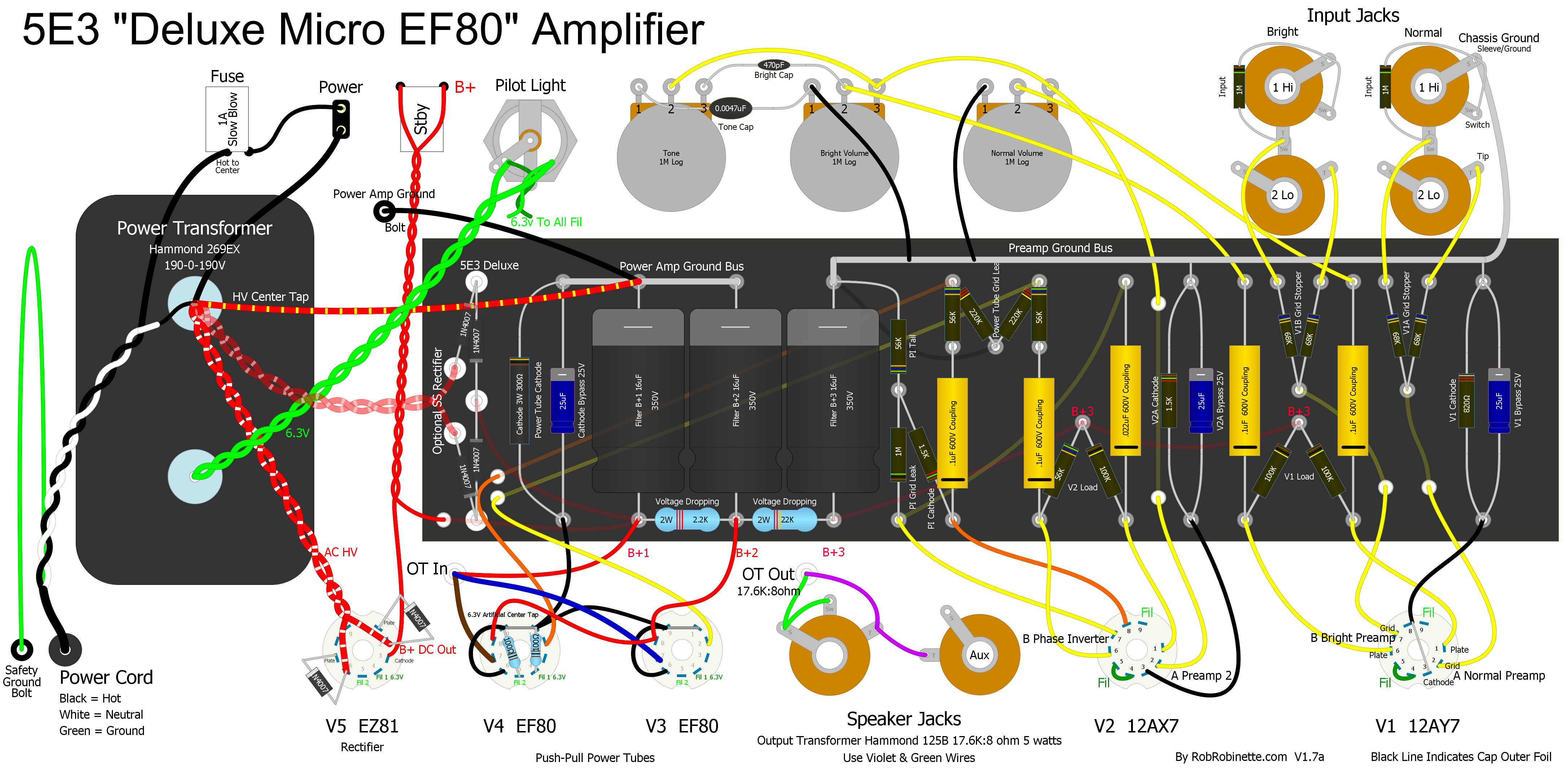
Wiring for an EZ81 tube rectifier is shown. An optional solid state full wave conventional rectifier is also shown with ghosted high voltage lines to the solid state rectifier. Choose tube or solid state rectification.
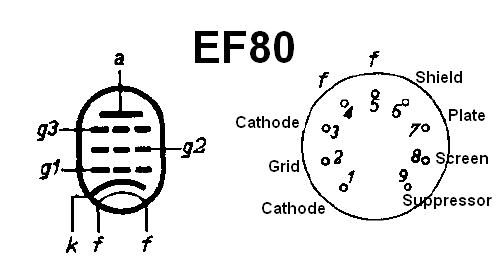
Pins 1 & 3 connect to a single cathode, pins 4 & 5 (f) are 6.3v heater filaments, pin 6 is an internal shield which is normally connected to the cathode or ground, pins 1 & 9 (cathode and suppressor grid) are normally tied together.
Hammond 125B Output Transformer Wiring & Specs
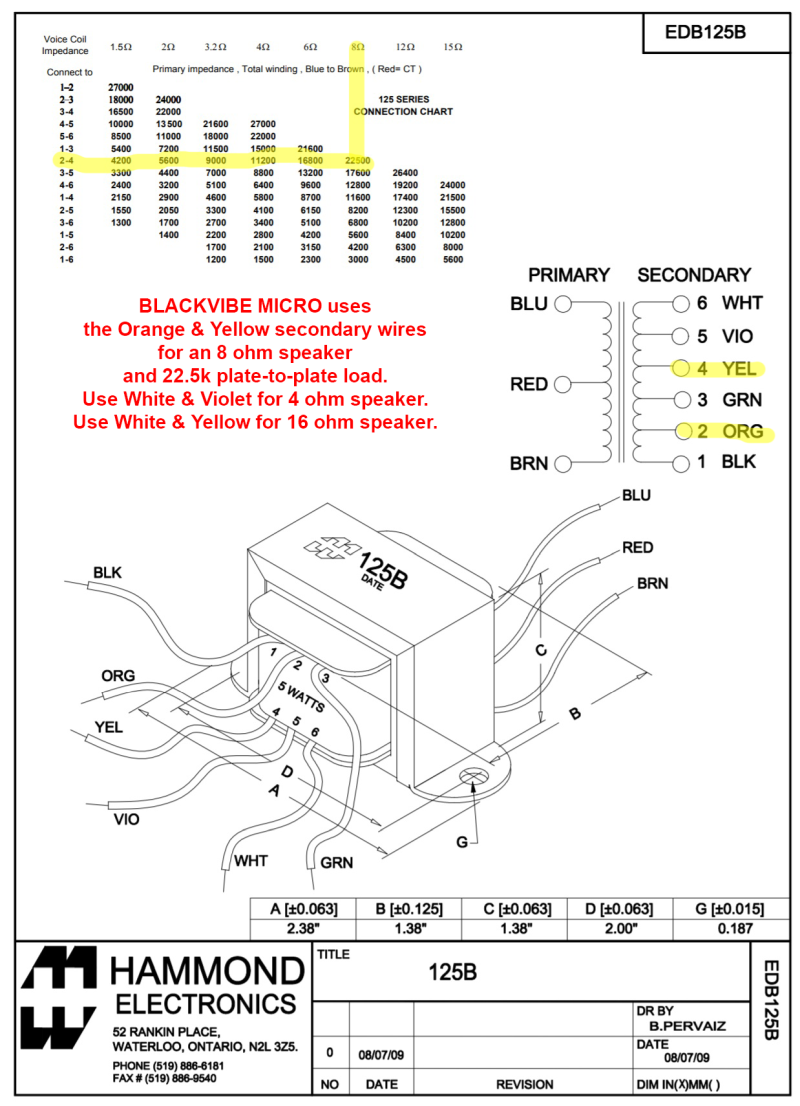
For the EF80 we want 22,500:8 ohms so we use the Yellow (4) & Orange (2) wires. We do not use the Black secondary wire.
Another (better looking) option for the output transformer is the $29 MusicalPowerSupplies.com OT5PP 22.5K:4-8-16 ohms.
Bill of Materials
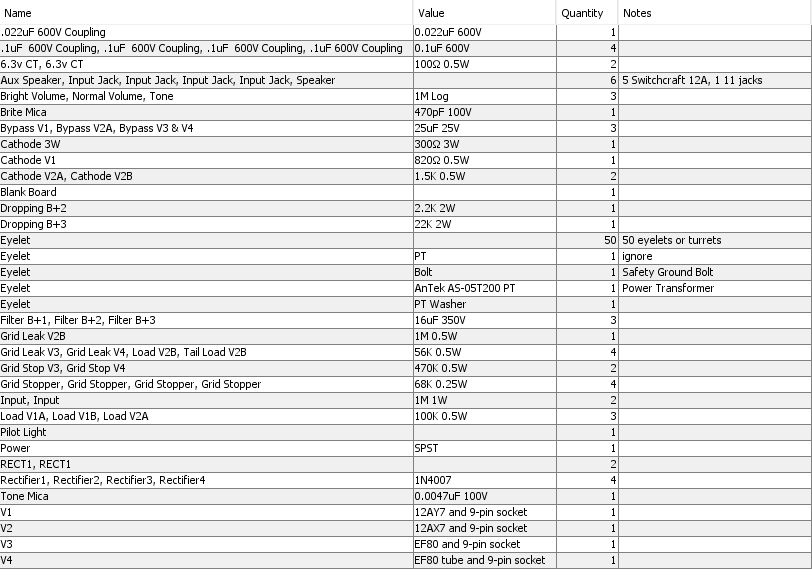
You will also need a power transformer, Hammond 125B output transformer, chassis, cab, speaker and power cord.
Self-Split Push-Pull Power Amp for the Deluxe Micro

Note: in the Deluxe Micro a 500KA Master Volume pot replaces the 330K Grid Leak resistor and the .0022uF snubber cap is not needed in this low-gain amp.
V2 is a self-split push-pull power tube. Output transformer is Hammond 125A using secondary wires 2 & 4 (yellow & orange) to give 22500:8 ohm load impedance for 8 ohm speaker. Try the amp without the .0022uF 1000v stability cap across the V2 plates. If the amp oscillates (high pitched screechy noise) then install the cap between V2 pins 1 & 6. Download the DIYLC file here.
If you prefer a push-pull power amp this puts out slightly less power than the single-ended parallel 12AU7 and I really didn't notice a change in tone compared to the single-ended parallel power tube. The only changes required for self-split push-pull are the V2 wiring and a push-pull output transformer (Hammond 125A). I measured 1 watt of clean power and a max of 1.2w with distortion using the push-pull 12AU7. I also tried an Electroharmonix 12BH7A and it measured 1 watt of clean but with a max of 2 watts. I went with the push-pull Hammond 125A using the secondary tap wires 2 and 4 (yellow & orange) for an 8 ohm speaker.
5E3MM Deluxe Micro Mod
Deluxe Micro With Optional Modifications
Bright switch, V1A cathode switch and negative feedback switch are added in the 'Mod' version of the Deluxe Micro. All of the switches give you the option of selecting the standard 5E3 Deluxe preamp.
The Bright Switch allows you to remove the bright cap to get the 5E3 Deluxe's Normal channel tone.
The Bypass Switch allows you to select three positions: Normal 5E3 / Unbypassed 2.7K cathode resistor / 2.7K with 1uF bypass cap. The 2.7K bypass resistor will bias the preamp stage cool and give early, asymmetric Marshall style clipping. Asymmetric clipping usually sounds "creamier" than standard symmetric clipping because half of the audio wave is undistorted and half is clipped.
Cathode bypass can be set to the 5E3 standard 25uF or 1uF or no bypass (switch center position). No bypass will reduce the amp's gain significantly and give more clean headroom. This position works well with high output guitar pickups. The 2.7k/1uF position will change the voicing of the amp and filter out some of the lows to reduce boomieness and prevent the amp from 'farting out.' Reducing some low freqs will also tighten and modernize the overdrive tone.
The Negative Feedback Switch changes the 5E3 Deluxe from a one trick pony to a very versatile amp by giving you more clean headroom at the flip of a switch so higher volume 'clean jazz' can be added to the 5E3's repertoire. Flip the switch back and you have your unaltered beloved 5E3 tone. Adding NFB 'civilizes' the 5E3 amp by increasing headroom, flattening frequency response and increasing bandwidth. It also decreases audible noise and hiss. NFB tends to sharpen the divide between clean and overdrive. The cleans are much cleaner and distortion will come on later giving you more headroom but when distortion does occur it tends to happen quicker so there can be more contrast between 'soft' and 'hard' picking. The unmodified 5E3 tends to break up early then smoothly transition into more overdrive distortion. NFB fundamentally alters the overdrive tone and shifts the balance of overdrive between the preamp and power tube (reduces power tube distortion). NFB also makes the amp more humbucker pickup friendly because it helps clean up the lower frequency distortion that can be overbearing and cause the amp to 'fart out' with high output pickups. This relatively easy 3-way feedback switch mod allows three distinct flavors of amplifier:
1. Feedback with no cathode bypass capacitor - lowest gain with tight lows, sharp transition to distortion, less noise and hiss and extra headroom for a very clean and civilized tone. This really transforms the amp and makes it much more versatile.
2. No feedback but with no V1B cathode bypass capacitor - moderate gain and civility--a nice compromise tone. This position reduces V1B's (2nd preamp) gain which shifts the 5E3's distortion balance so you'll get less preamp distortion but more power tube distortion at the same volume. If you do this mod you owe it to yourself to play around with this setting, it's pretty cool.
3. Normal 5E3 configuration with no feedback and the cathode bypass capacitor in circuit - highest gain and maximum early breakup tweediness.
If you use effects pedals, especially boost pedals, be sure and check out how the amp works with them and sample the overdrive tone in all 3 switch positions.
Deluxe Micro Mod Point-to-Point Layout
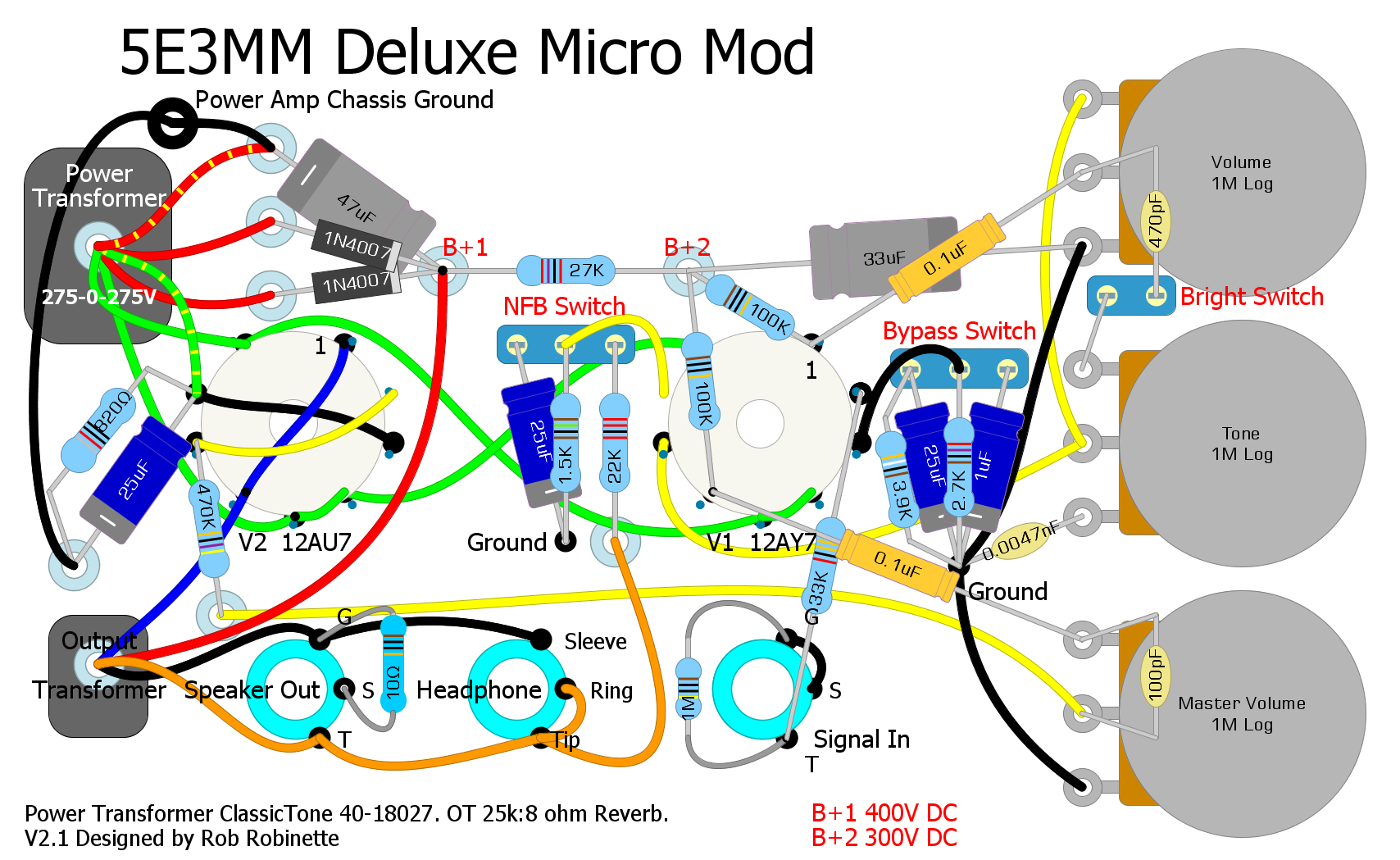
Stereo Deluxe Micro
This is a stereo audio amplifier created by Alan Gilsmith using two Deluxe Micro mono amps. More info is coming:
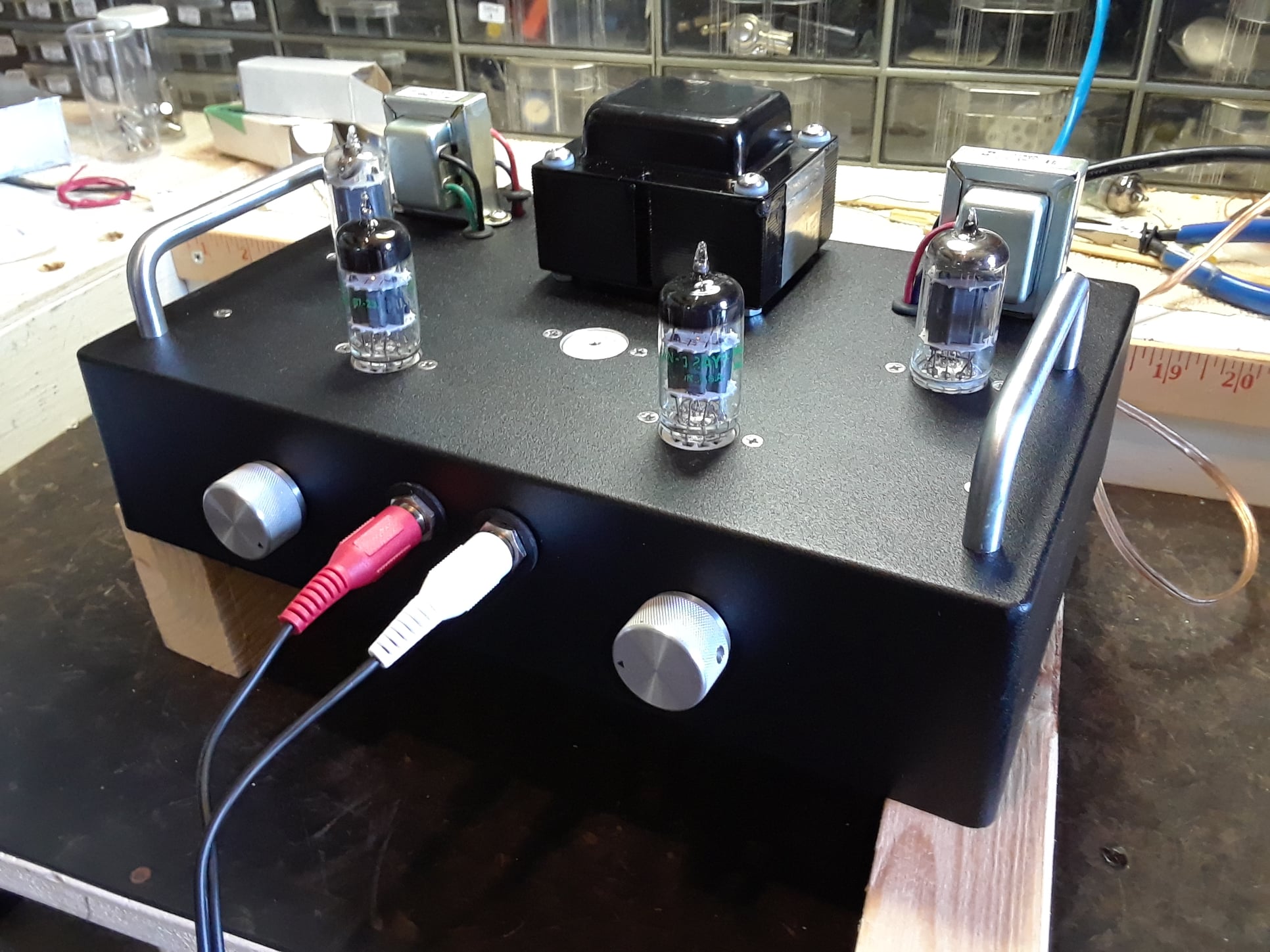
Alan used a Hammond 1550J aluminum chassis (10.83 in x 6.89 in x 2.46 in or 275 mm x 175 mm x 62 mm) for this build. The plugged tube hole in front of the power transformer is for an EZ81 tube rectifier he plans to add later.
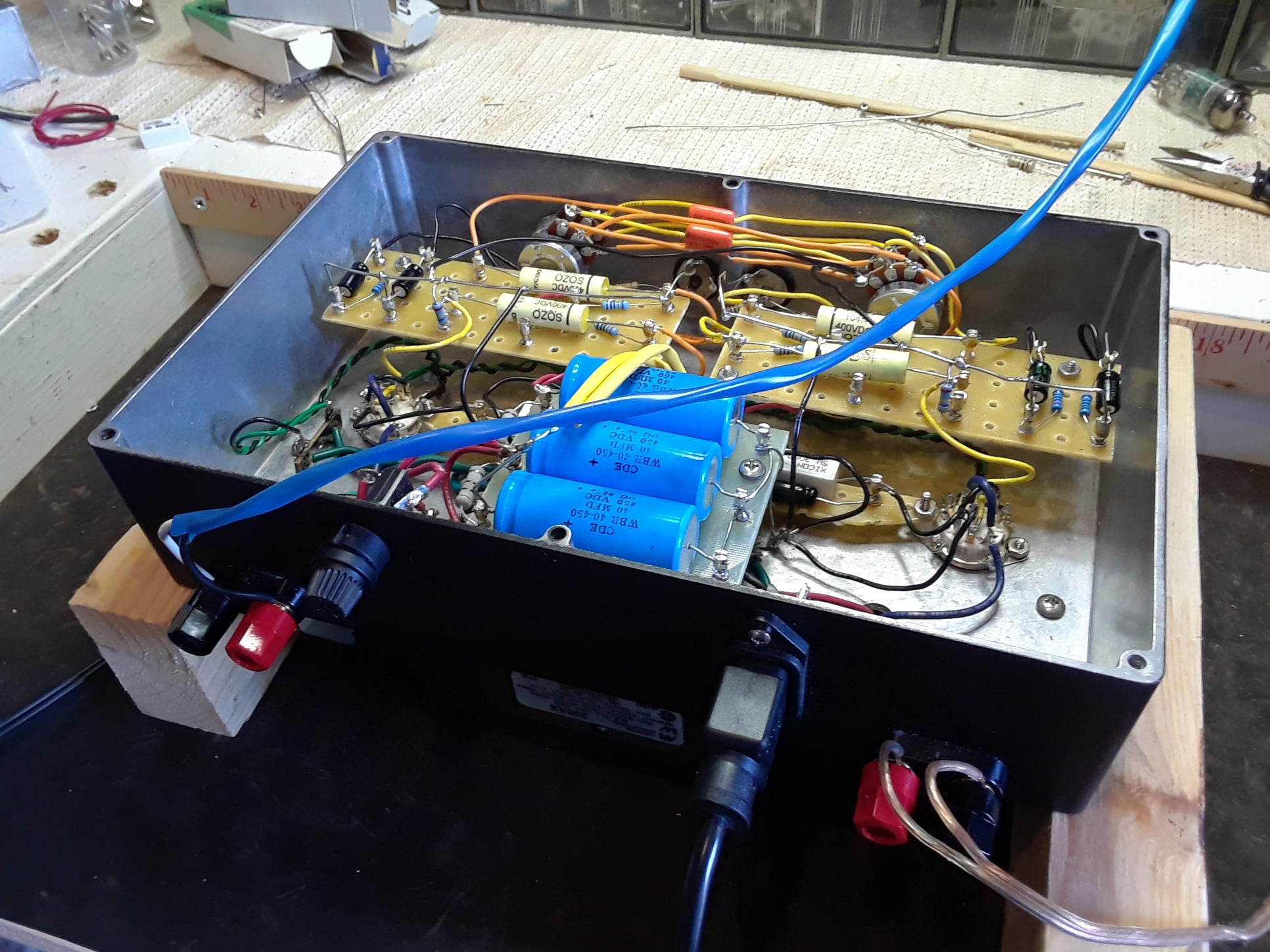
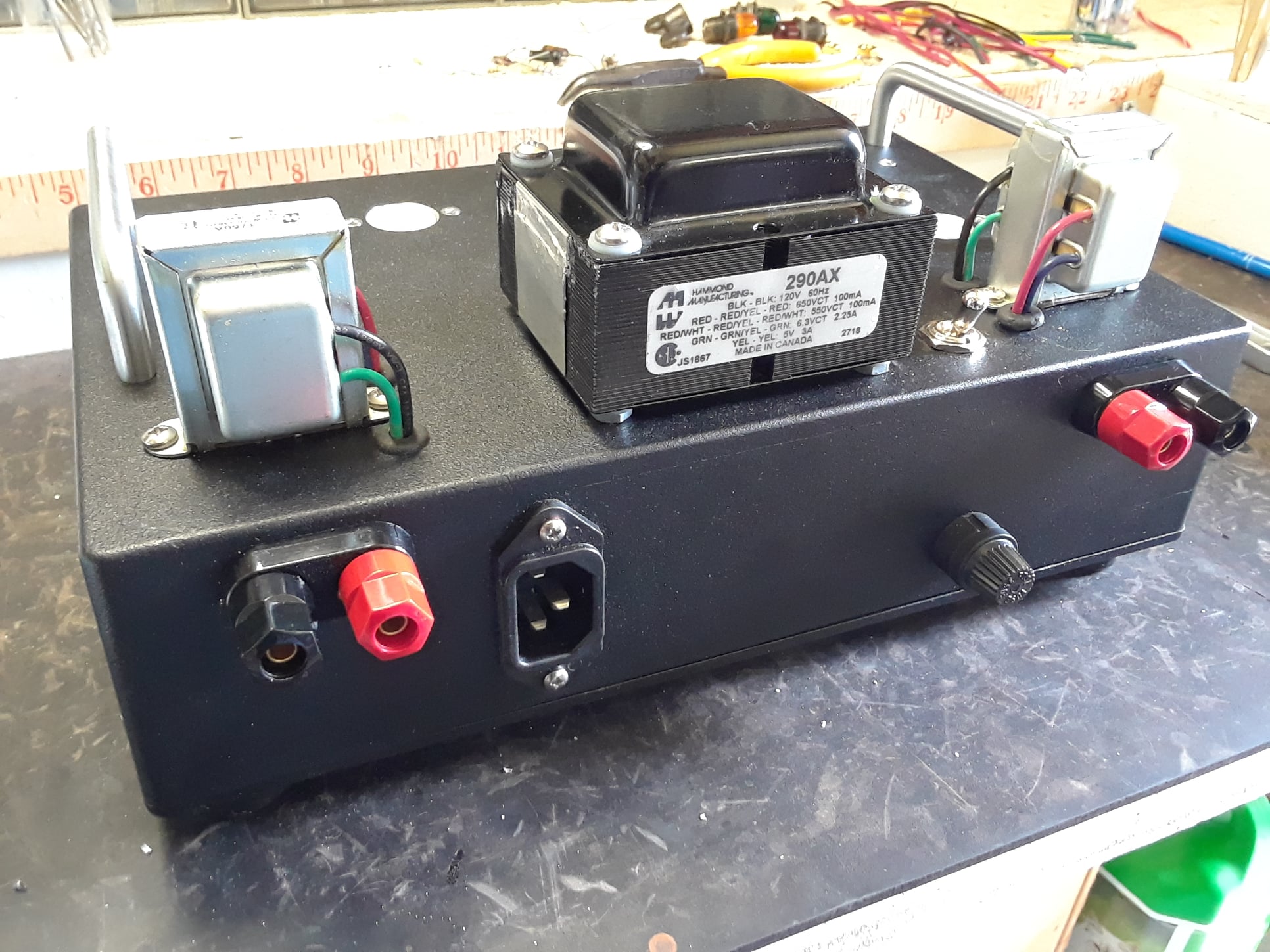
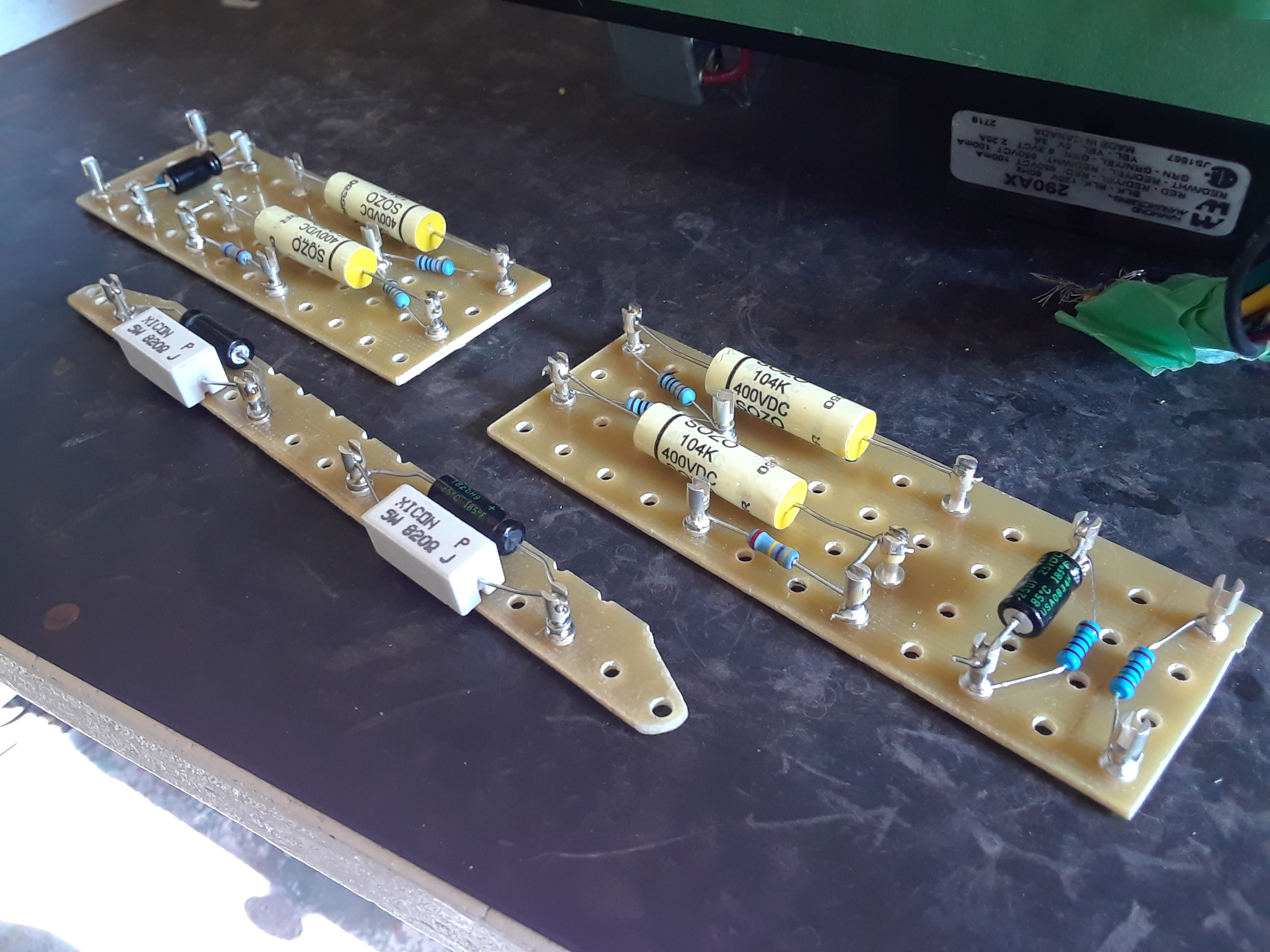
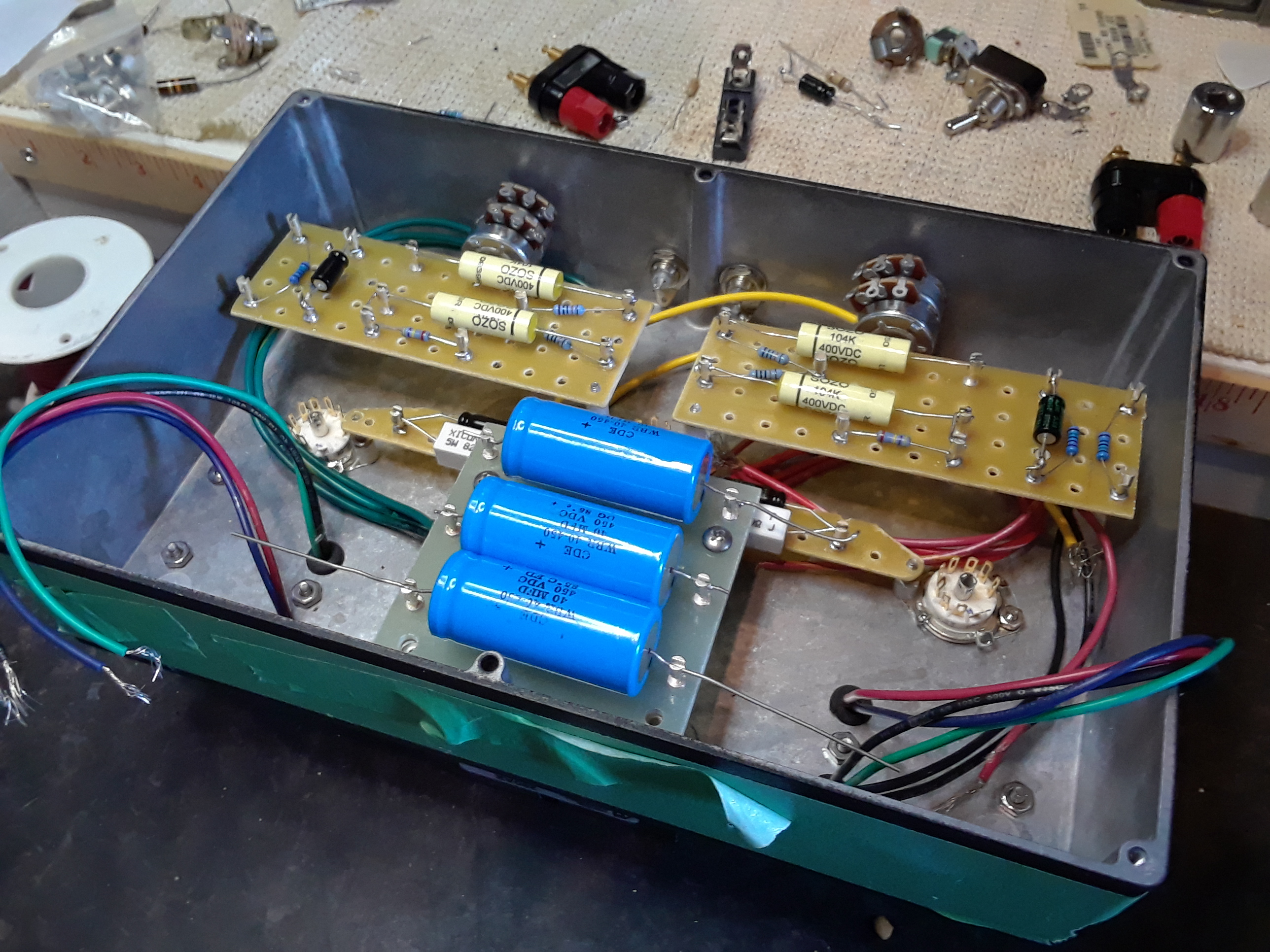
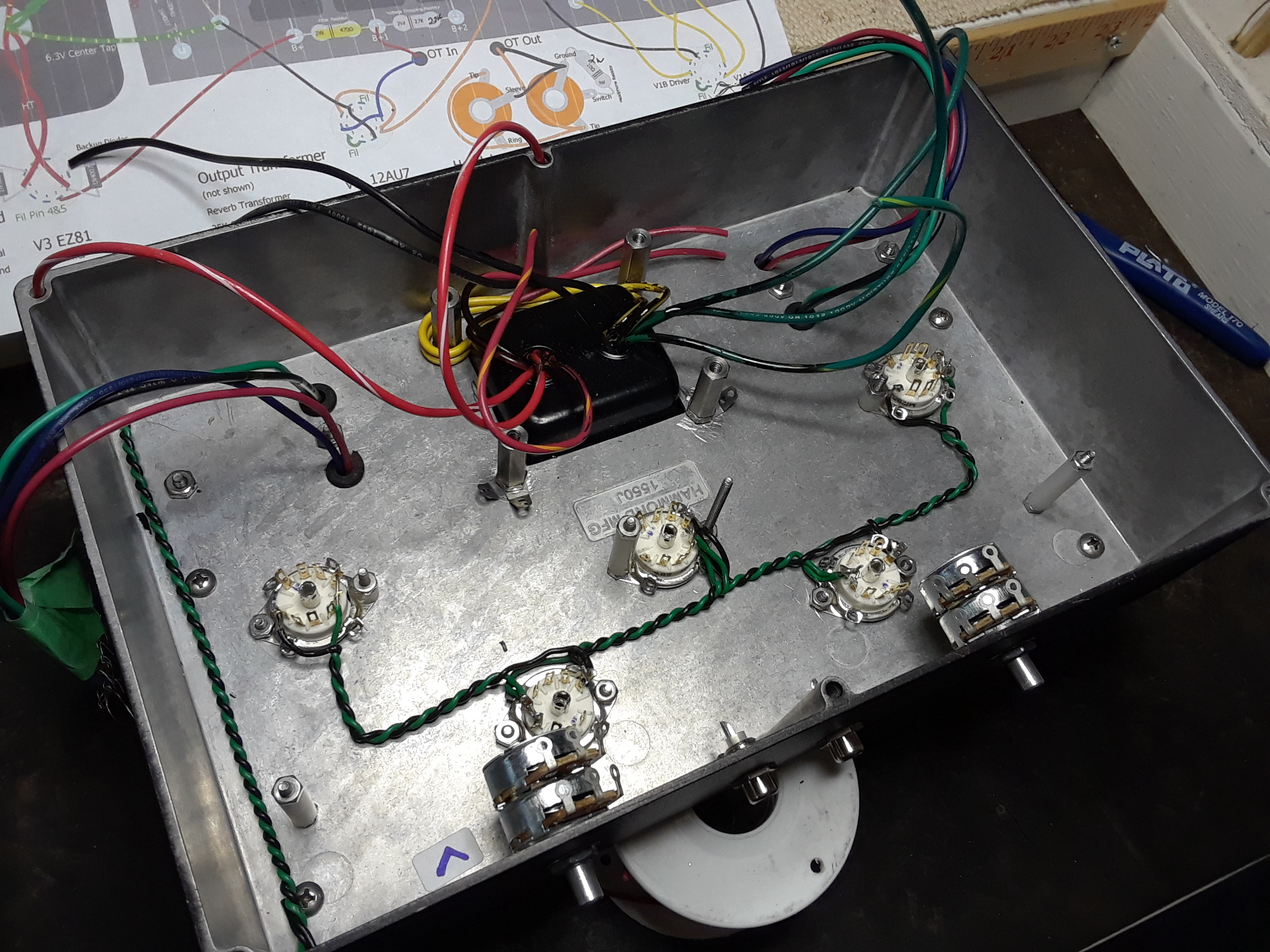
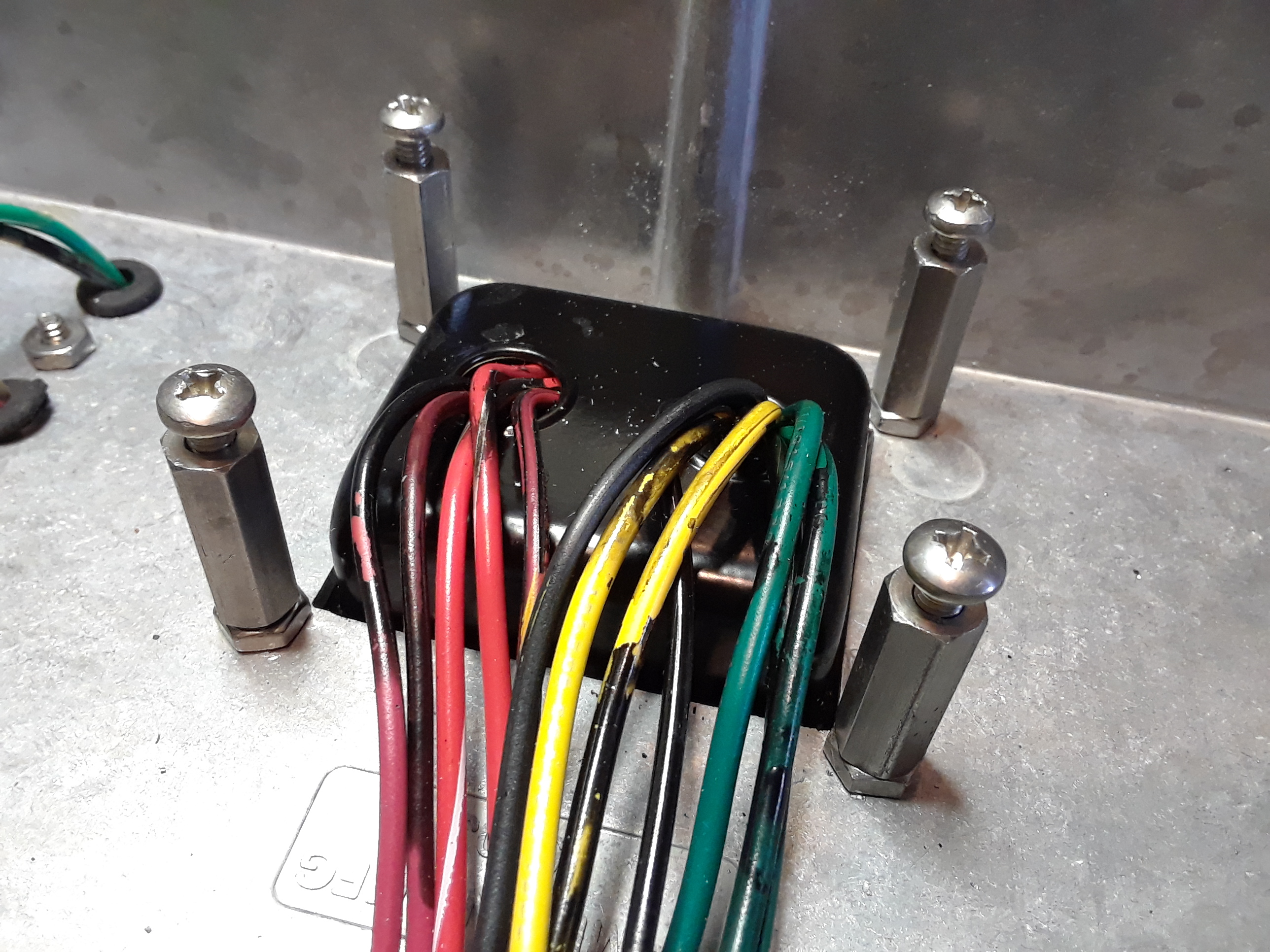
Modified Schematic Showing One Channel

The master volume has been deleted and global negative feedback has been added. The NFB adds fidelity and reduces distortion.
Firefly PCB 3.0 Amplifier Build
I bought a Firefly PCB and most of the components a couple of years ago and I decided to go ahead and build it while waiting for the components to finish the Deluxe Micro. I figured it would give me a baseline tone comparison for the Deluxe Micro. This was my first PCB amp and it was a very easy, relatively inexpensive build other than the iron. I got the PCB here for $19. I went with the recommended standard Hammond 269EX 190-0-190v power transformer ($50) and the Hammond 125E ($45) output transformer which is a little beefier (and expensive) than the recommended 125A. I also bought a Hammond 1444-16 10" x 6" x 2" aluminum chassis with finished wood end pieces but I haven't mounted anything in it yet.
The Firefly uses two 12AX7's for 2 or 4 stages of gain (switchable) and uses a 12AU7 in self-split push-pull mode for power. It sounds surprisingly good through an Eminence 620H 6" hemp coned speaker and an extension cab with a Weber Vintage 12A125A 12" AlNiCo speaker. The Firefly has a modern, polished tone compared to the vintage tweed of the Deluxe Micro. The Firefly's Boost gain stages push the little amp into a high gain preamp tube distorted frenzy.
Firefly with Power Transformer (black) and Output Transformer
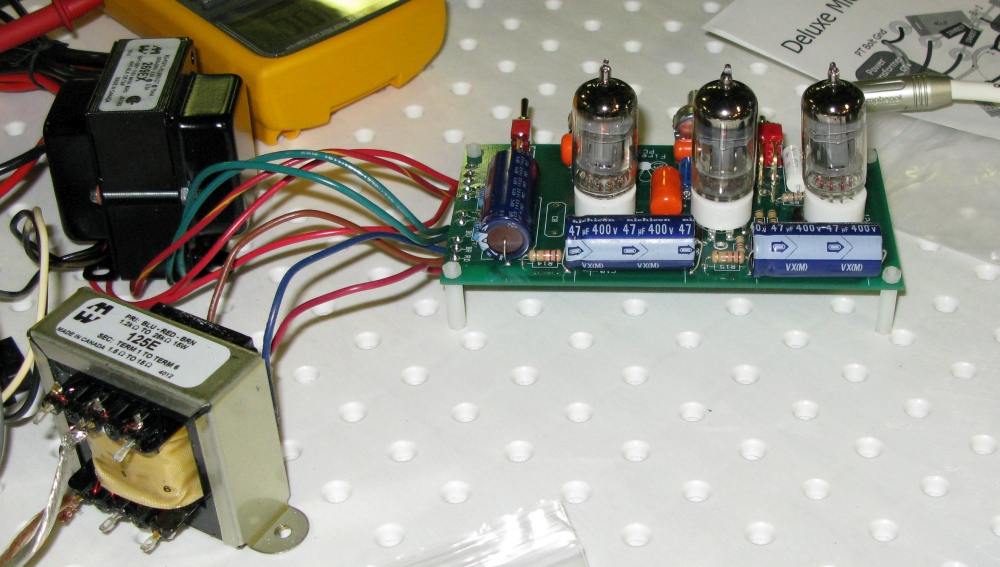
Bottom of PCB Showing Heater Wires
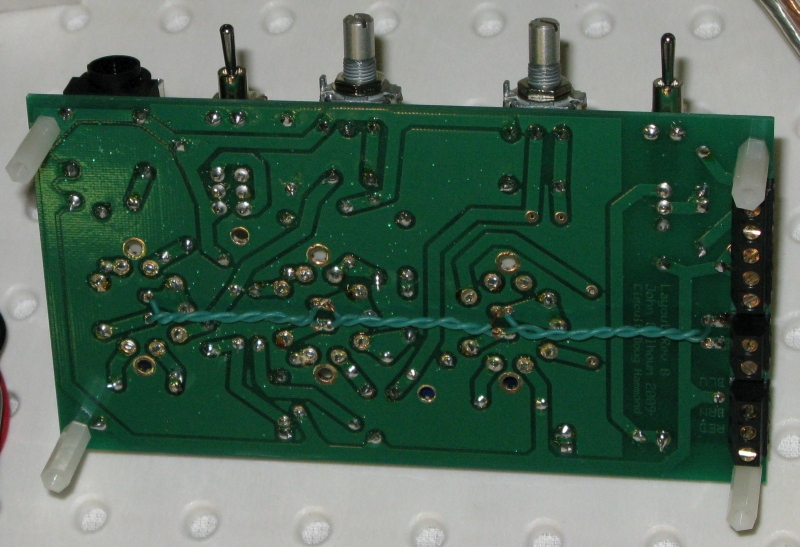
Firefly Schematic

Note that with self-split power tubes like this Firefly you cannot bypass the power tube cathode resistor with a cap. It will kill the signal to the lower power tube triode. Schematic by Doug Hammond
By Rob Robinette
References
RCA Corporation, RCA Receiving Tube Manual, RC30.
Merlin Blencowe, Designing Tube Preamps for Guitar and Bass, 2nd Edition.
Merlin Blencowe, Designing High-Fidelity Tube Preamps
Morgan Jones, Valve Amplifiers, 4th Edition.
Richard Kuehnel, Circuit Analysis of a Legendary Tube Amplifier: The Fender Bassman 5F6-A, 3rd Edition.
Richard Kuehnel, Vacuum Tube Circuit Design: Guitar Amplifier Preamps, 2nd Edition.
Richard Kuehnel, Vacuum Tube Circuit Design: Guitar Amplifier Power Amps
Robert C. Megantz, Design and Construction of Tube Guitar Amplifiers
Neumann & Irving, Guitar Amplifier Overdrive, A Visual Tour It's fairly technical but it's the only book written specifically about guitar amplifier overdrive. It includes many graphs to help make the material easier to understand.
T.E. Rutt, Vacuum Tube Triode Nonlinearity as Part of The Electric Guitar Sound
[ How the 5E3 Deluxe Works ] [ Deluxe Models ] [ DRRI & 68 CDR Mods ] [ Amp Troubleshooting ] [ My 5E3 Build ] [ Spice Analysis ] [ The Trainwreck Pages ] [ Fender Input Jacks ] [ B9A Prototype Boards ]
